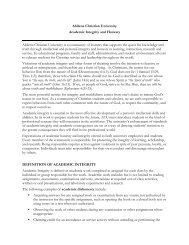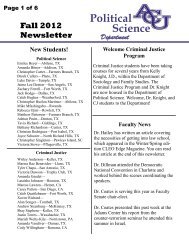The Influence of the Emperor Cult on the - Abilene Christian University
The Influence of the Emperor Cult on the - Abilene Christian University
The Influence of the Emperor Cult on the - Abilene Christian University
You also want an ePaper? Increase the reach of your titles
YUMPU automatically turns print PDFs into web optimized ePapers that Google loves.
THE INFLUENCE OF THE EMPEROR CULT ON<br />
THE BOOK OF REVELATION<br />
KENNETH CUKROWSKI<br />
<strong>Abilene</strong> <strong>Christian</strong> <strong>University</strong><br />
Am<strong>on</strong>g <str<strong>on</strong>g>the</str<strong>on</strong>g> courses I took from Ian Fair, his course <strong>on</strong> Revelati<strong>on</strong> illustrates<br />
<str<strong>on</strong>g>the</str<strong>on</strong>g> various ways that he impacted my future studies. Broadly speaking, I have<br />
applied myself to <str<strong>on</strong>g>the</str<strong>on</strong>g> field <str<strong>on</strong>g>of</str<strong>on</strong>g> NT studies. More narrowly, social historical<br />
questi<strong>on</strong>s, <str<strong>on</strong>g>of</str<strong>on</strong>g>ten answered through <str<strong>on</strong>g>the</str<strong>on</strong>g> use <str<strong>on</strong>g>of</str<strong>on</strong>g> Greek, dominate my interests.<br />
Thus with gratitude and c<strong>on</strong>gratulati<strong>on</strong>s I <str<strong>on</strong>g>of</str<strong>on</strong>g>fer this study <strong>on</strong> Revelati<strong>on</strong> to Ian<br />
Fair.<br />
Scholars disagree about <str<strong>on</strong>g>the</str<strong>on</strong>g> importance <str<strong>on</strong>g>of</str<strong>on</strong>g> <str<strong>on</strong>g>the</str<strong>on</strong>g> emperor cult for <str<strong>on</strong>g>the</str<strong>on</strong>g> interpretati<strong>on</strong><br />
<str<strong>on</strong>g>of</str<strong>on</strong>g> Revelati<strong>on</strong>. On <str<strong>on</strong>g>the</str<strong>on</strong>g> <strong>on</strong>e hand, G. E. M. Ste. Croix can say, “In fact,<br />
emperor-worship is a factor <str<strong>on</strong>g>of</str<strong>on</strong>g> almost no independent importance in <str<strong>on</strong>g>the</str<strong>on</strong>g> perse-<br />
1<br />
cuti<strong>on</strong>s <str<strong>on</strong>g>of</str<strong>on</strong>g> <str<strong>on</strong>g>the</str<strong>on</strong>g> <strong>Christian</strong>s.” On <str<strong>on</strong>g>the</str<strong>on</strong>g> o<str<strong>on</strong>g>the</str<strong>on</strong>g>r hand, D<strong>on</strong>ald L. J<strong>on</strong>es argues for <str<strong>on</strong>g>the</str<strong>on</strong>g><br />
significance <str<strong>on</strong>g>of</str<strong>on</strong>g> <str<strong>on</strong>g>the</str<strong>on</strong>g> emperor cult and <str<strong>on</strong>g>the</str<strong>on</strong>g> spread <str<strong>on</strong>g>of</str<strong>on</strong>g> persecuti<strong>on</strong>s c<strong>on</strong>nected to it:<br />
Deificati<strong>on</strong> <str<strong>on</strong>g>of</str<strong>on</strong>g> <str<strong>on</strong>g>the</str<strong>on</strong>g> emperor was now obligatory and used as a test to identity<br />
<strong>Christian</strong>s. Offerings <str<strong>on</strong>g>of</str<strong>on</strong>g> incense, prayers, and vows were expressi<strong>on</strong>s <str<strong>on</strong>g>of</str<strong>on</strong>g> loyalty to<br />
<str<strong>on</strong>g>the</str<strong>on</strong>g> state, and n<strong>on</strong>c<strong>on</strong>formists were c<strong>on</strong>sidered disloyal and punished. <str<strong>on</strong>g>The</str<strong>on</strong>g><br />
Domitianic persecuti<strong>on</strong> extended into Asia Minor, including several cities<br />
menti<strong>on</strong>ed in Revelati<strong>on</strong> 1–3 which were, at this time, important centers <str<strong>on</strong>g>of</str<strong>on</strong>g> emperor<br />
worship. 2<br />
Which <str<strong>on</strong>g>of</str<strong>on</strong>g> <str<strong>on</strong>g>the</str<strong>on</strong>g>se views better describes <str<strong>on</strong>g>the</str<strong>on</strong>g> role <str<strong>on</strong>g>of</str<strong>on</strong>g> <str<strong>on</strong>g>the</str<strong>on</strong>g> emperor cult? This<br />
investigati<strong>on</strong> proceeds in three stages: (1) <str<strong>on</strong>g>the</str<strong>on</strong>g> evidence for <str<strong>on</strong>g>the</str<strong>on</strong>g> emperor cult,<br />
(2) <str<strong>on</strong>g>the</str<strong>on</strong>g> nature <str<strong>on</strong>g>of</str<strong>on</strong>g> <str<strong>on</strong>g>the</str<strong>on</strong>g> emperor cult, and (3) <str<strong>on</strong>g>the</str<strong>on</strong>g> exegetical significance <str<strong>on</strong>g>of</str<strong>on</strong>g> <str<strong>on</strong>g>the</str<strong>on</strong>g><br />
emperor cult for <str<strong>on</strong>g>the</str<strong>on</strong>g> interpretati<strong>on</strong> <str<strong>on</strong>g>of</str<strong>on</strong>g> Revelati<strong>on</strong>.<br />
<str<strong>on</strong>g>The</str<strong>on</strong>g> Evidence for <str<strong>on</strong>g>the</str<strong>on</strong>g> <str<strong>on</strong>g>Emperor</str<strong>on</strong>g> <str<strong>on</strong>g>Cult</str<strong>on</strong>g><br />
1 G. E. M. de Ste. Croix, “Why Were <str<strong>on</strong>g>the</str<strong>on</strong>g> Early <strong>Christian</strong>s Persecuted?” in Studies<br />
in Ancient Society (ed. M. I. Finley; Bost<strong>on</strong>: Routledge & Kegan Paul, 1974), 216. Ste.<br />
Croix puts “no weight” <strong>on</strong> <str<strong>on</strong>g>the</str<strong>on</strong>g> <str<strong>on</strong>g>the</str<strong>on</strong>g>ory that under Domitian “emperor worship was<br />
enforced in Asia Minor, and that <str<strong>on</strong>g>the</str<strong>on</strong>g> <strong>Christian</strong> sect was proscribed when <strong>Christian</strong>s<br />
refused to take part in it, <str<strong>on</strong>g>the</str<strong>on</strong>g> charge being really political disloyalty.”<br />
2 D<strong>on</strong>ald L. J<strong>on</strong>es, “<strong>Christian</strong>ity and <str<strong>on</strong>g>the</str<strong>on</strong>g> Roman Imperial <str<strong>on</strong>g>Cult</str<strong>on</strong>g>,” ANRW 2.23.2<br />
(1034).
56 RESTORATION QUARTERLY<br />
Before exploring how <str<strong>on</strong>g>the</str<strong>on</strong>g> text <str<strong>on</strong>g>of</str<strong>on</strong>g> Revelati<strong>on</strong> can be illuminated by socialhistorical<br />
research, we will first examine <str<strong>on</strong>g>the</str<strong>on</strong>g> data for <str<strong>on</strong>g>the</str<strong>on</strong>g> emperor cult in <str<strong>on</strong>g>the</str<strong>on</strong>g><br />
cities <str<strong>on</strong>g>of</str<strong>on</strong>g> <str<strong>on</strong>g>the</str<strong>on</strong>g> Apocalypse and <str<strong>on</strong>g>the</str<strong>on</strong>g>n detail what can be said about <str<strong>on</strong>g>the</str<strong>on</strong>g> actual practices<br />
in <str<strong>on</strong>g>the</str<strong>on</strong>g> emperor cult. According to S. R. F. Price, evidence exists for <str<strong>on</strong>g>the</str<strong>on</strong>g><br />
emperor cult during or before <str<strong>on</strong>g>the</str<strong>on</strong>g> reign <str<strong>on</strong>g>of</str<strong>on</strong>g> Domitian in four <str<strong>on</strong>g>of</str<strong>on</strong>g> <str<strong>on</strong>g>the</str<strong>on</strong>g> seven cites<br />
menti<strong>on</strong>ed in Revelati<strong>on</strong> 2–3 (viz., Ephesus, Smyrna, Pergamum, and<br />
3 Laodicea). This secti<strong>on</strong> presents and evaluates <str<strong>on</strong>g>the</str<strong>on</strong>g> evidence for this claim.<br />
Ephesus<br />
In many respects, <str<strong>on</strong>g>the</str<strong>on</strong>g> evidence regarding Ephesus provides <str<strong>on</strong>g>the</str<strong>on</strong>g> best point<br />
<str<strong>on</strong>g>of</str<strong>on</strong>g> departure. <str<strong>on</strong>g>The</str<strong>on</strong>g> sources are varied, from archeological and epigraphic<br />
evidence to literary texts. In additi<strong>on</strong>, up to five temples are represented.<br />
<str<strong>on</strong>g>The</str<strong>on</strong>g> temple <str<strong>on</strong>g>of</str<strong>on</strong>g> Roma and Julius Caesar is <strong>on</strong>e <str<strong>on</strong>g>of</str<strong>on</strong>g> <str<strong>on</strong>g>the</str<strong>on</strong>g> few temples attested by<br />
literary evidence. Dio Cassius (fl. ca. A.D. 200) describes <str<strong>on</strong>g>the</str<strong>on</strong>g> h<strong>on</strong>ors Octavian<br />
granted Julius Caesar and Roma in 29 B.C.:<br />
Caesar (i.e., Octavian), meanwhile, besides attending to <str<strong>on</strong>g>the</str<strong>on</strong>g> general business, gave<br />
permissi<strong>on</strong> for <str<strong>on</strong>g>the</str<strong>on</strong>g> dedicati<strong>on</strong> <str<strong>on</strong>g>of</str<strong>on</strong>g> sacred precincts () in Ephesus and in<br />
Nicaea to Rome [i.e., Roma] and to Caesar, his fa<str<strong>on</strong>g>the</str<strong>on</strong>g>r, whom he named <str<strong>on</strong>g>the</str<strong>on</strong>g> hero<br />
Julius. <str<strong>on</strong>g>The</str<strong>on</strong>g>se cities had at that time attained chief place in Asia and in Bithynia<br />
respectively. He commanded that <str<strong>on</strong>g>the</str<strong>on</strong>g> Romans resident in <str<strong>on</strong>g>the</str<strong>on</strong>g>se cities should pay<br />
h<strong>on</strong>our to <str<strong>on</strong>g>the</str<strong>on</strong>g>se two divinities (’ . . . ); but he permitted <str<strong>on</strong>g>the</str<strong>on</strong>g><br />
aliens, whom he styled Hellenes, to c<strong>on</strong>secrate precincts () to himself,<br />
<str<strong>on</strong>g>the</str<strong>on</strong>g> Asians to have <str<strong>on</strong>g>the</str<strong>on</strong>g>irs in Pergamum and <str<strong>on</strong>g>the</str<strong>on</strong>g> Bithynians <str<strong>on</strong>g>the</str<strong>on</strong>g>irs in Nicomedia. This<br />
practice, beginning under him, has been c<strong>on</strong>tinued under o<str<strong>on</strong>g>the</str<strong>on</strong>g>r emperors, not <strong>on</strong>ly<br />
in <str<strong>on</strong>g>the</str<strong>on</strong>g> case <str<strong>on</strong>g>of</str<strong>on</strong>g> <str<strong>on</strong>g>the</str<strong>on</strong>g> Hellenic nati<strong>on</strong>s but also in that <str<strong>on</strong>g>of</str<strong>on</strong>g> all <str<strong>on</strong>g>the</str<strong>on</strong>g> o<str<strong>on</strong>g>the</str<strong>on</strong>g>rs, in so far as <str<strong>on</strong>g>the</str<strong>on</strong>g>y<br />
are subject to <str<strong>on</strong>g>the</str<strong>on</strong>g> Romans. For in <str<strong>on</strong>g>the</str<strong>on</strong>g> capital itself and in Italy generally no<br />
emperor, however worthy <str<strong>on</strong>g>of</str<strong>on</strong>g> renown he has been, has dared to do this; still, even<br />
<str<strong>on</strong>g>the</str<strong>on</strong>g>re various divine h<strong>on</strong>ours are bestowed ( )<br />
after <str<strong>on</strong>g>the</str<strong>on</strong>g>ir death up<strong>on</strong> such emperors as have ruled uprightly, and, in fact, shrines<br />
are built to <str<strong>on</strong>g>the</str<strong>on</strong>g>m ( ). 4<br />
A number <str<strong>on</strong>g>of</str<strong>on</strong>g> salient details require discussi<strong>on</strong>. First, <strong>on</strong>e notices <str<strong>on</strong>g>the</str<strong>on</strong>g><br />
menti<strong>on</strong> <str<strong>on</strong>g>of</str<strong>on</strong>g> “sacred precincts” to Roma and Julius Caesar in Ephesus. <str<strong>on</strong>g>The</str<strong>on</strong>g><br />
presence <str<strong>on</strong>g>of</str<strong>on</strong>g> <str<strong>on</strong>g>the</str<strong>on</strong>g>se “sacred precincts” is supported by archeological data: “This<br />
podium, formerly known as <str<strong>on</strong>g>the</str<strong>on</strong>g> state altar, has now been identified as a podium<br />
with two small prostyle temples built by Augustus in 29 B.C. for <str<strong>on</strong>g>the</str<strong>on</strong>g> Divus Iulius<br />
and Dea Roma; it was destroyed in <str<strong>on</strong>g>the</str<strong>on</strong>g> fourth century A.D.” 5<br />
3 S. R. F. Price, Rituals and Power: <str<strong>on</strong>g>The</str<strong>on</strong>g> Roman Imperial <str<strong>on</strong>g>Cult</str<strong>on</strong>g> in Asia Minor<br />
(Cambridge: Cambridge <strong>University</strong> Press, 1984), 252–64.<br />
4 Dio Cassius, Roman History, 51.20.6–8 (E. Cary, LCL 6.56–59).<br />
5 V. Mitsopoulou-Le<strong>on</strong>, “Ephesos,” Princet<strong>on</strong> Encyclopedia <str<strong>on</strong>g>of</str<strong>on</strong>g> Classical Sites, 307.<br />
For <str<strong>on</strong>g>the</str<strong>on</strong>g> locati<strong>on</strong> <str<strong>on</strong>g>of</str<strong>on</strong>g> <str<strong>on</strong>g>the</str<strong>on</strong>g> temple area, see #9 <strong>on</strong> <str<strong>on</strong>g>the</str<strong>on</strong>g> map between 760 and 761 (for discussi<strong>on</strong>,<br />
see 815–16) in “Ephesos vom Beginn der römischen Herrschaft in Kleinasien bis<br />
zum Ende der Principatszeit” (Dieter Knibbe and Wilhelm Alzinger, ANRW 2.7.2).
CUKROWSKI/INFLUENCE OF THE EMPEROR CULT 57<br />
Sec<strong>on</strong>d, Octavian c<strong>on</strong>secrates “precincts to himself” in Pergamum and<br />
Nicomedia, a practice that “has been c<strong>on</strong>tinued under o<str<strong>on</strong>g>the</str<strong>on</strong>g>r emperors.”<br />
However, Dio indicates that such a practice has not occurred “in <str<strong>on</strong>g>the</str<strong>on</strong>g> capital<br />
itself and in Italy generally.” This informati<strong>on</strong> suggests that <str<strong>on</strong>g>the</str<strong>on</strong>g> existence <str<strong>on</strong>g>of</str<strong>on</strong>g><br />
multiple imperial temples in Asia Minor is likely. Third, Dio’s testim<strong>on</strong>y also<br />
informs us that <str<strong>on</strong>g>the</str<strong>on</strong>g> bestowal <str<strong>on</strong>g>of</str<strong>on</strong>g> “divine h<strong>on</strong>ours” came from Rome (i.e., <str<strong>on</strong>g>the</str<strong>on</strong>g><br />
Senate) and occurred after <str<strong>on</strong>g>the</str<strong>on</strong>g> death <str<strong>on</strong>g>of</str<strong>on</strong>g> <str<strong>on</strong>g>the</str<strong>on</strong>g> emperor. <str<strong>on</strong>g>The</str<strong>on</strong>g> reliability <str<strong>on</strong>g>of</str<strong>on</strong>g> all this<br />
informati<strong>on</strong> from Dio is ano<str<strong>on</strong>g>the</str<strong>on</strong>g>r questi<strong>on</strong>. Although Dio is variously regarded<br />
6<br />
as a historian, <str<strong>on</strong>g>the</str<strong>on</strong>g> existence <str<strong>on</strong>g>of</str<strong>on</strong>g> <str<strong>on</strong>g>the</str<strong>on</strong>g> temple to Roma and Julius Caesar in<br />
Ephesus seems relatively certain, given <str<strong>on</strong>g>the</str<strong>on</strong>g> dual attestati<strong>on</strong> (literary and<br />
archaeological) <str<strong>on</strong>g>of</str<strong>on</strong>g> <str<strong>on</strong>g>the</str<strong>on</strong>g> evidence.<br />
<str<strong>on</strong>g>The</str<strong>on</strong>g> sec<strong>on</strong>d temple associated with Ephesus is <str<strong>on</strong>g>the</str<strong>on</strong>g> temple <str<strong>on</strong>g>of</str<strong>on</strong>g> Augustus at <str<strong>on</strong>g>the</str<strong>on</strong>g><br />
Artemisi<strong>on</strong>. An inscripti<strong>on</strong> in <str<strong>on</strong>g>the</str<strong>on</strong>g> British Museum (#522) records “<str<strong>on</strong>g>the</str<strong>on</strong>g><br />
rebuilding <str<strong>on</strong>g>of</str<strong>on</strong>g> <str<strong>on</strong>g>the</str<strong>on</strong>g> peribolos <str<strong>on</strong>g>of</str<strong>on</strong>g> <str<strong>on</strong>g>the</str<strong>on</strong>g> Artemisi<strong>on</strong> by order <str<strong>on</strong>g>of</str<strong>on</strong>g> Augustus, B.C. 6.” 7<br />
<str<strong>on</strong>g>The</str<strong>on</strong>g> <str<strong>on</strong>g>Emperor</str<strong>on</strong>g>, Caesar, S<strong>on</strong> <str<strong>on</strong>g>of</str<strong>on</strong>g> God, Augustus; (in) <str<strong>on</strong>g>the</str<strong>on</strong>g> 12th c<strong>on</strong>sulate, <str<strong>on</strong>g>the</str<strong>on</strong>g> 18th<br />
tribunate power; from <str<strong>on</strong>g>the</str<strong>on</strong>g> revenues <str<strong>on</strong>g>of</str<strong>on</strong>g> <str<strong>on</strong>g>the</str<strong>on</strong>g> god was provided to build a wall for <str<strong>on</strong>g>the</str<strong>on</strong>g><br />
temple and <str<strong>on</strong>g>the</str<strong>on</strong>g> Sebastei<strong>on</strong>; in <str<strong>on</strong>g>the</str<strong>on</strong>g> proc<strong>on</strong>sulship <str<strong>on</strong>g>of</str<strong>on</strong>g> Gaius Asinius Gallus, in <str<strong>on</strong>g>the</str<strong>on</strong>g><br />
care <str<strong>on</strong>g>of</str<strong>on</strong>g> Sextus Lartidius, ambassador [trans. mine].<br />
A debate exists whe<str<strong>on</strong>g>the</str<strong>on</strong>g>r <str<strong>on</strong>g>the</str<strong>on</strong>g> Artemisi<strong>on</strong> and <str<strong>on</strong>g>the</str<strong>on</strong>g> Sebastei<strong>on</strong> shared <str<strong>on</strong>g>the</str<strong>on</strong>g> same<br />
8 precincts. Whatever <str<strong>on</strong>g>the</str<strong>on</strong>g> case, <str<strong>on</strong>g>the</str<strong>on</strong>g> inscripti<strong>on</strong> describes <str<strong>on</strong>g>the</str<strong>on</strong>g> building <str<strong>on</strong>g>of</str<strong>on</strong>g> a wall<br />
that served both <str<strong>on</strong>g>the</str<strong>on</strong>g> Artemisi<strong>on</strong> and <str<strong>on</strong>g>the</str<strong>on</strong>g> Sebastei<strong>on</strong>. More importantly, <str<strong>on</strong>g>the</str<strong>on</strong>g><br />
inscripti<strong>on</strong> provides evidence <str<strong>on</strong>g>of</str<strong>on</strong>g> an imperial temple for Augustus while he was<br />
still alive.<br />
6 In OCD (s. v. “Dio Cassius,” 345), Alexander McD<strong>on</strong>ald writes, “Unreliable<br />
about republican instituti<strong>on</strong>s and c<strong>on</strong>diti<strong>on</strong>s, from Caesar <strong>on</strong>wards he used his c<strong>on</strong>stituti<strong>on</strong>al<br />
experience, at first colouring events with his ideas <str<strong>on</strong>g>of</str<strong>on</strong>g> imperial absolutism, but<br />
later handling his material with full knowledge.” A similar sentiment is echoed by<br />
H. Koester, “<str<strong>on</strong>g>The</str<strong>on</strong>g> value and reliability <str<strong>on</strong>g>of</str<strong>on</strong>g> this work (Dio’s Roman History) is debated.<br />
Dio Cassius was largely dependent up<strong>on</strong> Latin annalists, inserted numerous l<strong>on</strong>g<br />
speeches, and showed independent judgment <strong>on</strong>ly in <str<strong>on</strong>g>the</str<strong>on</strong>g> treatment <str<strong>on</strong>g>of</str<strong>on</strong>g> his own period”<br />
(History, <str<strong>on</strong>g>Cult</str<strong>on</strong>g>ure, and Religi<strong>on</strong> <str<strong>on</strong>g>of</str<strong>on</strong>g> <str<strong>on</strong>g>the</str<strong>on</strong>g> Hellenistic Age, [Philadelphia: Fortress, 1982],<br />
350).<br />
7 <str<strong>on</strong>g>The</str<strong>on</strong>g> Collecti<strong>on</strong> <str<strong>on</strong>g>of</str<strong>on</strong>g> Ancient Greek Inscripti<strong>on</strong>s in <str<strong>on</strong>g>the</str<strong>on</strong>g> British Museum, Part 3—<br />
Secti<strong>on</strong> 2, Ephesos (ed. E. L. Hicks; Oxford: Clarend<strong>on</strong> Press, 1890), 177.<br />
8 A. D. Nock argues, “it should be remembered that two distinct , or<br />
precincts, can have a comm<strong>on</strong> wall and make a sacred enclosure like <str<strong>on</strong>g>the</str<strong>on</strong>g> Acropolis <str<strong>on</strong>g>of</str<strong>on</strong>g><br />
A<str<strong>on</strong>g>the</str<strong>on</strong>g>ns. This is not temple-sharing” (Essays <strong>on</strong> Religi<strong>on</strong> and <str<strong>on</strong>g>the</str<strong>on</strong>g> Ancient World [ed.<br />
Zeph Stewart; Cambridge: Harvard <strong>University</strong> Press, 1972], 225). According to Price<br />
(Rituals, 254), Jobst (“Zur Lokalisierung des Sebastei<strong>on</strong>-Augusteum in Ephesos,”<br />
Mitteilungen des Deutschen Archäologischen Instituts, Abteilung Istanbul 30 [1980]:<br />
241–60) argues that <str<strong>on</strong>g>the</str<strong>on</strong>g> Sebastei<strong>on</strong> was not in <str<strong>on</strong>g>the</str<strong>on</strong>g> Artemisi<strong>on</strong> because <str<strong>on</strong>g>the</str<strong>on</strong>g> inscripti<strong>on</strong><br />
was not found <str<strong>on</strong>g>the</str<strong>on</strong>g>re.
58 RESTORATION QUARTERLY<br />
<str<strong>on</strong>g>The</str<strong>on</strong>g> temple <str<strong>on</strong>g>of</str<strong>on</strong>g> Augustus in Ephesus, <str<strong>on</strong>g>the</str<strong>on</strong>g> third imperial temple, is attested<br />
by an inscripti<strong>on</strong>. <str<strong>on</strong>g>The</str<strong>on</strong>g> inscripti<strong>on</strong> (#902) is primarily a list <str<strong>on</strong>g>of</str<strong>on</strong>g> names, perhaps<br />
9<br />
<str<strong>on</strong>g>the</str<strong>on</strong>g> names <str<strong>on</strong>g>of</str<strong>on</strong>g> priests. Thus <strong>on</strong>ly <str<strong>on</strong>g>the</str<strong>on</strong>g> first five lines are significant for our<br />
purposes.<br />
Apoll<strong>on</strong>ius, s<strong>on</strong> <str<strong>on</strong>g>of</str<strong>on</strong>g> Herakleidos,<br />
s<strong>on</strong> <str<strong>on</strong>g>of</str<strong>on</strong>g> Passalas, who provided for <str<strong>on</strong>g>the</str<strong>on</strong>g><br />
foundati<strong>on</strong> <str<strong>on</strong>g>of</str<strong>on</strong>g> Augustus<br />
and <str<strong>on</strong>g>the</str<strong>on</strong>g> dedicati<strong>on</strong><br />
<str<strong>on</strong>g>of</str<strong>on</strong>g> <str<strong>on</strong>g>the</str<strong>on</strong>g> precincts [trans. mine].<br />
Although this temple and <str<strong>on</strong>g>the</str<strong>on</strong>g> sec<strong>on</strong>d temple could be <str<strong>on</strong>g>the</str<strong>on</strong>g> same temple, no <strong>on</strong>e<br />
10<br />
makes this claim. Thus this inscripti<strong>on</strong> appears to point to a third imperial<br />
temple in Ephesus. A fourth piece <str<strong>on</strong>g>of</str<strong>on</strong>g> evidence is a fragmentary inscripti<strong>on</strong> (12<br />
pieces) that reportedly attests <str<strong>on</strong>g>the</str<strong>on</strong>g> existence <str<strong>on</strong>g>of</str<strong>on</strong>g> a “royal portico” ( [<br />
11<br />
) dedicated in part to <str<strong>on</strong>g>the</str<strong>on</strong>g> emperor. Fur<str<strong>on</strong>g>the</str<strong>on</strong>g>r evidence for imperial nature<br />
12<br />
<str<strong>on</strong>g>of</str<strong>on</strong>g> <str<strong>on</strong>g>the</str<strong>on</strong>g> stoa are <str<strong>on</strong>g>the</str<strong>on</strong>g> statues <str<strong>on</strong>g>of</str<strong>on</strong>g> Augustus and Livia found in situ. However,<br />
nei<str<strong>on</strong>g>the</str<strong>on</strong>g>r <str<strong>on</strong>g>the</str<strong>on</strong>g> stoa nor <str<strong>on</strong>g>the</str<strong>on</strong>g> statues prove <str<strong>on</strong>g>the</str<strong>on</strong>g> presence <str<strong>on</strong>g>of</str<strong>on</strong>g> an imperial cult temple.<br />
Perhaps <strong>on</strong>e <str<strong>on</strong>g>of</str<strong>on</strong>g> <str<strong>on</strong>g>the</str<strong>on</strong>g> most interesting pieces <str<strong>on</strong>g>of</str<strong>on</strong>g> evidence for <str<strong>on</strong>g>the</str<strong>on</strong>g> interpretati<strong>on</strong><br />
<str<strong>on</strong>g>of</str<strong>on</strong>g> Revelati<strong>on</strong> is <str<strong>on</strong>g>the</str<strong>on</strong>g> existence <str<strong>on</strong>g>of</str<strong>on</strong>g> <str<strong>on</strong>g>the</str<strong>on</strong>g> temple <str<strong>on</strong>g>of</str<strong>on</strong>g> Domitian. Mitsopoulou-Le<strong>on</strong><br />
indicates, “<str<strong>on</strong>g>The</str<strong>on</strong>g> temple was originally dedicated to Domitian by <str<strong>on</strong>g>the</str<strong>on</strong>g> Province <str<strong>on</strong>g>of</str<strong>on</strong>g><br />
Asia (<str<strong>on</strong>g>the</str<strong>on</strong>g> first Neokorie <str<strong>on</strong>g>of</str<strong>on</strong>g> Ephesos) and after his damnatio memoriae<br />
13<br />
rededicated to his fa<str<strong>on</strong>g>the</str<strong>on</strong>g>r Vespasian.” As <str<strong>on</strong>g>the</str<strong>on</strong>g> first imperial neocorate <str<strong>on</strong>g>of</str<strong>on</strong>g><br />
14<br />
Ephesus, <str<strong>on</strong>g>the</str<strong>on</strong>g> temple dates A.D. 82–84. A number <str<strong>on</strong>g>of</str<strong>on</strong>g> inscripti<strong>on</strong>s support <str<strong>on</strong>g>the</str<strong>on</strong>g><br />
identificati<strong>on</strong> <str<strong>on</strong>g>of</str<strong>on</strong>g> this temple as <str<strong>on</strong>g>the</str<strong>on</strong>g> temple <str<strong>on</strong>g>of</str<strong>on</strong>g> Domitian. Many <str<strong>on</strong>g>of</str<strong>on</strong>g> <str<strong>on</strong>g>the</str<strong>on</strong>g> inscripti<strong>on</strong>s<br />
have <str<strong>on</strong>g>the</str<strong>on</strong>g> name <str<strong>on</strong>g>of</str<strong>on</strong>g> Domitian partially erased, an erasure c<strong>on</strong>nected with <str<strong>on</strong>g>the</str<strong>on</strong>g><br />
9 Die Inschriften v<strong>on</strong> Ephesos, Teil III (ed. H. Engelmann, D. Knibbe, and R.<br />
Merkelbach; B<strong>on</strong>n: Rudolf Habelt,1980), 203. Price (Rituals, 254) dates <str<strong>on</strong>g>the</str<strong>on</strong>g> inscripti<strong>on</strong><br />
to ca. 27 B.C. <str<strong>on</strong>g>The</str<strong>on</strong>g> dating is based <strong>on</strong> <str<strong>on</strong>g>the</str<strong>on</strong>g> identificati<strong>on</strong> <str<strong>on</strong>g>of</str<strong>on</strong>g> some <str<strong>on</strong>g>of</str<strong>on</strong>g> <str<strong>on</strong>g>the</str<strong>on</strong>g> names in <str<strong>on</strong>g>the</str<strong>on</strong>g> list.<br />
See Die Inschriften v<strong>on</strong> Ephesos, 203–4.<br />
10 According to Price (Rituals, 254), <strong>on</strong>e likely locati<strong>on</strong> is “in <str<strong>on</strong>g>the</str<strong>on</strong>g> centre <str<strong>on</strong>g>of</str<strong>on</strong>g> <str<strong>on</strong>g>the</str<strong>on</strong>g> upper<br />
square.”<br />
11 Die Inschriften v<strong>on</strong> Ephesos, Teil II (ed. C. Barker and R. Merkelbach; B<strong>on</strong>n:<br />
Rudolf Habelt, 1979), 132–33 (#404). A significant porti<strong>on</strong> <str<strong>on</strong>g>of</str<strong>on</strong>g> this bilingual inscripti<strong>on</strong><br />
is restored. <str<strong>on</strong>g>The</str<strong>on</strong>g> Latin does not appear to help to <str<strong>on</strong>g>the</str<strong>on</strong>g> degree <str<strong>on</strong>g>of</str<strong>on</strong>g> <str<strong>on</strong>g>the</str<strong>on</strong>g> restorati<strong>on</strong> in Greek:<br />
[ ’] [ ’ ] [ <br />
] [ ] [ ’ .<br />
12 See W. Alzinger, “Das Regierungsviertel,” 264–65.<br />
13 V. Mitsopoulou-Le<strong>on</strong>, “Ephesos,” 308. For <str<strong>on</strong>g>the</str<strong>on</strong>g> locati<strong>on</strong> <str<strong>on</strong>g>of</str<strong>on</strong>g> <str<strong>on</strong>g>the</str<strong>on</strong>g> temple, see #15 <strong>on</strong><br />
<str<strong>on</strong>g>the</str<strong>on</strong>g> map in ANRW 2.7.2 (760).<br />
14 W. Alzinger, s.v. “Nachträge—Ephesos,” Paulys Realencyclopädie der<br />
classischen Altertumswissenschaft, Supp. 12 (Stuttgart: Alfred Druckenmüller, 1970),<br />
1650.
CUKROWSKI/INFLUENCE OF THE EMPEROR CULT 59<br />
15<br />
damnatio memoriae. <str<strong>on</strong>g>The</str<strong>on</strong>g> archaeological evidence also supports <str<strong>on</strong>g>the</str<strong>on</strong>g> presence<br />
16<br />
<str<strong>on</strong>g>of</str<strong>on</strong>g> <str<strong>on</strong>g>the</str<strong>on</strong>g> temple. In sum, we have evidence <str<strong>on</strong>g>of</str<strong>on</strong>g> <str<strong>on</strong>g>the</str<strong>on</strong>g> presence <str<strong>on</strong>g>of</str<strong>on</strong>g> a temple to<br />
Domitian in Ephesus dating from <str<strong>on</strong>g>the</str<strong>on</strong>g> early eighties.<br />
Smyrna<br />
In Smyrna is a temple dedicated to Tiberius, Livia, and <str<strong>on</strong>g>the</str<strong>on</strong>g> Senate. Tacitus<br />
recounts <str<strong>on</strong>g>the</str<strong>on</strong>g> origins <str<strong>on</strong>g>of</str<strong>on</strong>g> this temple in his Annals:<br />
<str<strong>on</strong>g>The</str<strong>on</strong>g> case [against Lucilius Capito, <str<strong>on</strong>g>the</str<strong>on</strong>g> procurator <str<strong>on</strong>g>of</str<strong>on</strong>g> Asia] was accordingly tried and<br />
<str<strong>on</strong>g>the</str<strong>on</strong>g> defendant c<strong>on</strong>demned. In return for this act <str<strong>on</strong>g>of</str<strong>on</strong>g> retributi<strong>on</strong>, as well as for <str<strong>on</strong>g>the</str<strong>on</strong>g><br />
punishment meted out to Gaius Silanus <str<strong>on</strong>g>the</str<strong>on</strong>g> year before, <str<strong>on</strong>g>the</str<strong>on</strong>g> Asiatic cities decreed<br />
a temple to Tiberius, his mo<str<strong>on</strong>g>the</str<strong>on</strong>g>r [Livia], and <str<strong>on</strong>g>the</str<strong>on</strong>g> senate. Leave to build was<br />
granted. 17<br />
However, after three years <str<strong>on</strong>g>the</str<strong>on</strong>g> cities <str<strong>on</strong>g>of</str<strong>on</strong>g> Asia were still arguing which city should<br />
receive <str<strong>on</strong>g>the</str<strong>on</strong>g> temple. <str<strong>on</strong>g>The</str<strong>on</strong>g> Senate c<strong>on</strong>vened to hear <str<strong>on</strong>g>the</str<strong>on</strong>g> claims <str<strong>on</strong>g>of</str<strong>on</strong>g> eleven cities.<br />
With no great variety each pleaded nati<strong>on</strong>al antiquity, and zeal for <str<strong>on</strong>g>the</str<strong>on</strong>g> Roman cause<br />
in <str<strong>on</strong>g>the</str<strong>on</strong>g> wars. . . . But Hypaepa and Tralles, toge<str<strong>on</strong>g>the</str<strong>on</strong>g>r with Laodicea and Magnesia,<br />
were passed over as inadequate to <str<strong>on</strong>g>the</str<strong>on</strong>g> task. . . . <str<strong>on</strong>g>The</str<strong>on</strong>g> Pergamenes (see “Pergamum”<br />
below) were refuted by <str<strong>on</strong>g>the</str<strong>on</strong>g>ir main argument: <str<strong>on</strong>g>the</str<strong>on</strong>g>y had already a sanctuary <str<strong>on</strong>g>of</str<strong>on</strong>g><br />
Augustus, and <str<strong>on</strong>g>the</str<strong>on</strong>g> distincti<strong>on</strong> was thought ample. <str<strong>on</strong>g>The</str<strong>on</strong>g> state-worship in Ephesus and<br />
Miletus was c<strong>on</strong>sidered to be already centred <strong>on</strong> <str<strong>on</strong>g>the</str<strong>on</strong>g> cults <str<strong>on</strong>g>of</str<strong>on</strong>g> Diana and Apollo<br />
respectively: <str<strong>on</strong>g>the</str<strong>on</strong>g> deliberati<strong>on</strong>s turned, <str<strong>on</strong>g>the</str<strong>on</strong>g>refore, <strong>on</strong> Sardis and Smyrna. 18<br />
<str<strong>on</strong>g>The</str<strong>on</strong>g> Senate chose Smyrna as <str<strong>on</strong>g>the</str<strong>on</strong>g> locati<strong>on</strong> for <str<strong>on</strong>g>the</str<strong>on</strong>g> temple and selected a legate,<br />
Valerius Naso, to oversee <str<strong>on</strong>g>the</str<strong>on</strong>g> task (Annals, 4.56). Rounding out <str<strong>on</strong>g>the</str<strong>on</strong>g> literary<br />
evidence are various coins indicating <str<strong>on</strong>g>the</str<strong>on</strong>g> presence <str<strong>on</strong>g>of</str<strong>on</strong>g> a temple dedicated to<br />
19 Tiberius as well as to Livia and <str<strong>on</strong>g>the</str<strong>on</strong>g> Senate.<br />
Pergamum<br />
<str<strong>on</strong>g>The</str<strong>on</strong>g> imperial temple in Pergamum played a significant role in <str<strong>on</strong>g>the</str<strong>on</strong>g> life <str<strong>on</strong>g>of</str<strong>on</strong>g> <str<strong>on</strong>g>the</str<strong>on</strong>g><br />
citizens in <str<strong>on</strong>g>the</str<strong>on</strong>g> province <str<strong>on</strong>g>of</str<strong>on</strong>g> Asia. As already noted in <str<strong>on</strong>g>the</str<strong>on</strong>g> citati<strong>on</strong> from Dio, a<br />
temple to Octavian was established in Pergamum in 29 B.C. <str<strong>on</strong>g>The</str<strong>on</strong>g> temple is<br />
15 <str<strong>on</strong>g>The</str<strong>on</strong>g>re are at least fourteen inscripti<strong>on</strong>s for <str<strong>on</strong>g>the</str<strong>on</strong>g> temple <str<strong>on</strong>g>of</str<strong>on</strong>g> Domitian. See Die<br />
Inschriften v<strong>on</strong> Ephesos, Teil II, #232–42; Teil V, #1498; Teil VI, #2048.<br />
16 W. Alzinger, “Ephesos (Archäologisch),” ANRW 2.72 (820). For photos and<br />
schematic drawings <str<strong>on</strong>g>of</str<strong>on</strong>g> <str<strong>on</strong>g>the</str<strong>on</strong>g> temple, terrace, and street <str<strong>on</strong>g>of</str<strong>on</strong>g> Domitian, see H. Vetters,<br />
“Domitianterrasse und Domitiangasse,” Jahreshefte des Österreichischen Archäologischen<br />
Institutes 50. Beiblatt (1972–1975): 311–30.<br />
17 Tacitus, Ann., 4.15 (trans. John Jacks<strong>on</strong>; LCL; Cambridge: Harvard <strong>University</strong><br />
Press, 1937), 29.<br />
18 Tacitus, Ann., 4.15.<br />
19 Note <str<strong>on</strong>g>the</str<strong>on</strong>g> numerous coins menti<strong>on</strong>ed in Steven J. Friesen, Imperial <str<strong>on</strong>g>Cult</str<strong>on</strong>g>s and <str<strong>on</strong>g>the</str<strong>on</strong>g><br />
Apocalypse <str<strong>on</strong>g>of</str<strong>on</strong>g> John: Reading Revelati<strong>on</strong> in <str<strong>on</strong>g>the</str<strong>on</strong>g> Ruins (Oxford: Oxford <strong>University</strong> Press,<br />
2001), 38; and in Price (Rituals, 258 nn. 45–46).
60 RESTORATION QUARTERLY<br />
important not <strong>on</strong>ly because it “became <str<strong>on</strong>g>the</str<strong>on</strong>g> center <str<strong>on</strong>g>of</str<strong>on</strong>g> <str<strong>on</strong>g>the</str<strong>on</strong>g> imperial cult in <str<strong>on</strong>g>the</str<strong>on</strong>g><br />
province <str<strong>on</strong>g>of</str<strong>on</strong>g> Asia,” but also because it “became <str<strong>on</strong>g>the</str<strong>on</strong>g> religious and political center<br />
20<br />
<str<strong>on</strong>g>of</str<strong>on</strong>g> <str<strong>on</strong>g>the</str<strong>on</strong>g> Koin<strong>on</strong> <str<strong>on</strong>g>of</str<strong>on</strong>g> Asia—<str<strong>on</strong>g>the</str<strong>on</strong>g> organizati<strong>on</strong> <str<strong>on</strong>g>of</str<strong>on</strong>g> <str<strong>on</strong>g>the</str<strong>on</strong>g> cities <str<strong>on</strong>g>of</str<strong>on</strong>g> Asia.” As <str<strong>on</strong>g>the</str<strong>on</strong>g> meeting<br />
place <str<strong>on</strong>g>of</str<strong>on</strong>g> <str<strong>on</strong>g>the</str<strong>on</strong>g> Koin<strong>on</strong> <str<strong>on</strong>g>of</str<strong>on</strong>g> Asia, Pergamum sp<strong>on</strong>sored annual games, <str<strong>on</strong>g>the</str<strong>on</strong>g> Romaia<br />
Sebasta, when <str<strong>on</strong>g>the</str<strong>on</strong>g> Koin<strong>on</strong> assembled. In additi<strong>on</strong>, <str<strong>on</strong>g>the</str<strong>on</strong>g> temple precincts “served<br />
as a repository for decrees <str<strong>on</strong>g>of</str<strong>on</strong>g> <str<strong>on</strong>g>the</str<strong>on</strong>g> Koin<strong>on</strong>, letters from Rome, and decrees<br />
h<strong>on</strong>oring provincial priests or o<str<strong>on</strong>g>the</str<strong>on</strong>g>r <str<strong>on</strong>g>of</str<strong>on</strong>g>ficials <str<strong>on</strong>g>of</str<strong>on</strong>g> <str<strong>on</strong>g>the</str<strong>on</strong>g> Koin<strong>on</strong>, with stelai set up <strong>on</strong><br />
21<br />
<str<strong>on</strong>g>the</str<strong>on</strong>g> temenos or even in <str<strong>on</strong>g>the</str<strong>on</strong>g> temple itself.” Unfortunately, no archaeological<br />
22<br />
evidence <str<strong>on</strong>g>of</str<strong>on</strong>g> <str<strong>on</strong>g>the</str<strong>on</strong>g> temple has been unear<str<strong>on</strong>g>the</str<strong>on</strong>g>d. Despite <str<strong>on</strong>g>the</str<strong>on</strong>g> absence <str<strong>on</strong>g>of</str<strong>on</strong>g> archaeological<br />
evidence, <str<strong>on</strong>g>the</str<strong>on</strong>g> c<strong>on</strong>fluence <str<strong>on</strong>g>of</str<strong>on</strong>g> <str<strong>on</strong>g>the</str<strong>on</strong>g> literary evidence from Dio and Tacitus with <str<strong>on</strong>g>the</str<strong>on</strong>g><br />
23<br />
numismatic evidence render <str<strong>on</strong>g>the</str<strong>on</strong>g> existence <str<strong>on</strong>g>of</str<strong>on</strong>g> <str<strong>on</strong>g>the</str<strong>on</strong>g> temple in Pergamum virtually<br />
certain.<br />
Laodicea<br />
<str<strong>on</strong>g>The</str<strong>on</strong>g> evidence for an imperial temple in Laodicea is entirely numismatic.<br />
For instance, F. Imho<str<strong>on</strong>g>of</str<strong>on</strong>g>-Blumer describes <strong>on</strong>e <str<strong>on</strong>g>of</str<strong>on</strong>g> <str<strong>on</strong>g>the</str<strong>on</strong>g> coins found at Laodicea:<br />
Obverse: in a circular legend and<br />
in <str<strong>on</strong>g>the</str<strong>on</strong>g> field . Facing busts <str<strong>on</strong>g>of</str<strong>on</strong>g> Domitian victorious and breastplated<br />
<strong>on</strong> <str<strong>on</strong>g>the</str<strong>on</strong>g> right and Domitia in draped clothing <strong>on</strong> <str<strong>on</strong>g>the</str<strong>on</strong>g> left.<br />
Reverse: . —. Temple with four columns, <str<strong>on</strong>g>of</str<strong>on</strong>g><br />
which <str<strong>on</strong>g>the</str<strong>on</strong>g> frieze carries <str<strong>on</strong>g>the</str<strong>on</strong>g> inscripti<strong>on</strong> ; inside Domitian stands <strong>on</strong> <str<strong>on</strong>g>the</str<strong>on</strong>g><br />
left in military dress; Domitia stands <strong>on</strong> <str<strong>on</strong>g>the</str<strong>on</strong>g> right; each <strong>on</strong>e is supported by a<br />
scepter and extends his/her hand [trans. mine]. 24<br />
Imho<str<strong>on</strong>g>of</str<strong>on</strong>g>-Blumer notes that <str<strong>on</strong>g>the</str<strong>on</strong>g> first phrase <strong>on</strong> <str<strong>on</strong>g>the</str<strong>on</strong>g> reverse probably indicates <str<strong>on</strong>g>the</str<strong>on</strong>g><br />
magistrate in whose reign <str<strong>on</strong>g>the</str<strong>on</strong>g> coin was stamped. More important is <str<strong>on</strong>g>the</str<strong>on</strong>g> inscripti<strong>on</strong><br />
<strong>on</strong> <str<strong>on</strong>g>the</str<strong>on</strong>g> temple frieze. Imho<str<strong>on</strong>g>of</str<strong>on</strong>g>-Blumer gives <str<strong>on</strong>g>the</str<strong>on</strong>g> following interpretati<strong>on</strong>:<br />
<str<strong>on</strong>g>The</str<strong>on</strong>g> adjective seems to refer to <str<strong>on</strong>g>the</str<strong>on</strong>g> temple () which <str<strong>on</strong>g>the</str<strong>on</strong>g> frieze<br />
decorates. Since <str<strong>on</strong>g>the</str<strong>on</strong>g> emperor represents himself in military costume, carrying a<br />
trophy, between <str<strong>on</strong>g>the</str<strong>on</strong>g> columns <str<strong>on</strong>g>of</str<strong>on</strong>g> <str<strong>on</strong>g>the</str<strong>on</strong>g> building, it is permissible to believe that <str<strong>on</strong>g>the</str<strong>on</strong>g><br />
20 R<strong>on</strong>ald Mellor, : <str<strong>on</strong>g>The</str<strong>on</strong>g> Worship <str<strong>on</strong>g>of</str<strong>on</strong>g> <str<strong>on</strong>g>the</str<strong>on</strong>g> Goddess Roma in <str<strong>on</strong>g>the</str<strong>on</strong>g> Greek<br />
World (Göttingen: Vandenhoeck & Ruprecht, 1975), 80.<br />
21 Mellor, Roma, 81, 141.<br />
22 Note <str<strong>on</strong>g>the</str<strong>on</strong>g> silence <str<strong>on</strong>g>of</str<strong>on</strong>g> J. Schäfer, “Pergam<strong>on</strong>,” Princet<strong>on</strong> Encyclopedia <str<strong>on</strong>g>of</str<strong>on</strong>g> Classical<br />
Sites, 688–92. Schäfer does menti<strong>on</strong> “a room which served for <str<strong>on</strong>g>the</str<strong>on</strong>g> cult <str<strong>on</strong>g>of</str<strong>on</strong>g> <str<strong>on</strong>g>the</str<strong>on</strong>g> emperor”<br />
(689). Mellor, Roma, 141.<br />
23 See Friesen, Imperial <str<strong>on</strong>g>Cult</str<strong>on</strong>g>s, 29–30.<br />
24 F. Imho<str<strong>on</strong>g>of</str<strong>on</strong>g>-Blumer, M<strong>on</strong>naies grecques (Amsterdam: Johannes Müller, 1883),<br />
404–5. <str<strong>on</strong>g>The</str<strong>on</strong>g> episil<strong>on</strong>s are lunate, which I have approximated by enlarging a small-case<br />
episil<strong>on</strong>. Also, <str<strong>on</strong>g>the</str<strong>on</strong>g> KOP is a m<strong>on</strong>ogram.
CUKROWSKI/INFLUENCE OF THE EMPEROR CULT 61<br />
temple had been erected or c<strong>on</strong>secrated to Domitian, in h<strong>on</strong>or <str<strong>on</strong>g>of</str<strong>on</strong>g> his victories which<br />
made him triumph and take <str<strong>on</strong>g>the</str<strong>on</strong>g> title <str<strong>on</strong>g>of</str<strong>on</strong>g> Germanicus, in 84 A.D. [trans. mine]. 25<br />
26<br />
O<str<strong>on</strong>g>the</str<strong>on</strong>g>r coins give similar informati<strong>on</strong> for a temple to Domitian in Laodicea<br />
circa 84 A.D. 27<br />
In summary, each <str<strong>on</strong>g>of</str<strong>on</strong>g> <str<strong>on</strong>g>the</str<strong>on</strong>g>se four cities had imperial temples. At least two <str<strong>on</strong>g>of</str<strong>on</strong>g><br />
<str<strong>on</strong>g>the</str<strong>on</strong>g>m (Ephesus and Laodicea) erected a temple to Domitian in <str<strong>on</strong>g>the</str<strong>on</strong>g> early to mid<br />
eighties. Ano<str<strong>on</strong>g>the</str<strong>on</strong>g>r, namely Pergamum, functi<strong>on</strong>ed as <str<strong>on</strong>g>the</str<strong>on</strong>g> Koin<strong>on</strong> for <str<strong>on</strong>g>the</str<strong>on</strong>g> province<br />
<str<strong>on</strong>g>of</str<strong>on</strong>g> Asia. However, this informati<strong>on</strong> gives <strong>on</strong>ly half <str<strong>on</strong>g>the</str<strong>on</strong>g> story. What happened in<br />
<str<strong>on</strong>g>the</str<strong>on</strong>g>se imperial temples? What was <str<strong>on</strong>g>the</str<strong>on</strong>g> nature <str<strong>on</strong>g>of</str<strong>on</strong>g> <str<strong>on</strong>g>the</str<strong>on</strong>g> cult in <str<strong>on</strong>g>the</str<strong>on</strong>g>se temples? Is<br />
<str<strong>on</strong>g>the</str<strong>on</strong>g>re any evidence <str<strong>on</strong>g>of</str<strong>on</strong>g> forced sacrifice?<br />
<str<strong>on</strong>g>The</str<strong>on</strong>g> Nature <str<strong>on</strong>g>of</str<strong>on</strong>g> <str<strong>on</strong>g>the</str<strong>on</strong>g> <str<strong>on</strong>g>Emperor</str<strong>on</strong>g> <str<strong>on</strong>g>Cult</str<strong>on</strong>g><br />
This secti<strong>on</strong> focuses <strong>on</strong> <str<strong>on</strong>g>the</str<strong>on</strong>g> practices <str<strong>on</strong>g>of</str<strong>on</strong>g> <str<strong>on</strong>g>the</str<strong>on</strong>g> emperor cult. Unfortunately, <str<strong>on</strong>g>the</str<strong>on</strong>g><br />
sources for rec<strong>on</strong>structing this aspect are not as extensive as <strong>on</strong>e might like. In<br />
fact, Price states, “<str<strong>on</strong>g>the</str<strong>on</strong>g>re is no extended c<strong>on</strong>temporary discussi<strong>on</strong> <str<strong>on</strong>g>of</str<strong>on</strong>g> imperial<br />
28<br />
ritual in <str<strong>on</strong>g>the</str<strong>on</strong>g> provinces.” Probably most germane to <str<strong>on</strong>g>the</str<strong>on</strong>g> interpretati<strong>on</strong> <str<strong>on</strong>g>of</str<strong>on</strong>g><br />
Revelati<strong>on</strong> is <str<strong>on</strong>g>the</str<strong>on</strong>g> descripti<strong>on</strong> <str<strong>on</strong>g>of</str<strong>on</strong>g> sacrifices in <str<strong>on</strong>g>the</str<strong>on</strong>g> emperor cult. <str<strong>on</strong>g>The</str<strong>on</strong>g> most<br />
extensive literary descripti<strong>on</strong> <str<strong>on</strong>g>of</str<strong>on</strong>g> <str<strong>on</strong>g>the</str<strong>on</strong>g> emperor cult comes from Nicolaus <str<strong>on</strong>g>of</str<strong>on</strong>g><br />
Damascus (fl. 20 B.C.). His Universal History c<strong>on</strong>tains <str<strong>on</strong>g>the</str<strong>on</strong>g> following citati<strong>on</strong>:<br />
Because mankind address him thus (as Sebastos) in accordance with <str<strong>on</strong>g>the</str<strong>on</strong>g>ir<br />
estimati<strong>on</strong> <str<strong>on</strong>g>of</str<strong>on</strong>g> his h<strong>on</strong>our, <str<strong>on</strong>g>the</str<strong>on</strong>g>y revere him with temples and sacrifices over islands<br />
and c<strong>on</strong>tinents, organized in cities and provinces, matching <str<strong>on</strong>g>the</str<strong>on</strong>g> greatness <str<strong>on</strong>g>of</str<strong>on</strong>g> his<br />
virtue and repaying his benefacti<strong>on</strong>s towards <str<strong>on</strong>g>the</str<strong>on</strong>g>m. 29<br />
Perhaps <str<strong>on</strong>g>the</str<strong>on</strong>g> closest to a descripti<strong>on</strong> <str<strong>on</strong>g>of</str<strong>on</strong>g> an imperial sacrifice comes from an<br />
inscripti<strong>on</strong> from Gy<str<strong>on</strong>g>the</str<strong>on</strong>g>um near Sparta.<br />
A processi<strong>on</strong> made its way from <str<strong>on</strong>g>the</str<strong>on</strong>g> temple <str<strong>on</strong>g>of</str<strong>on</strong>g> Asclepius and Hygeia, <str<strong>on</strong>g>the</str<strong>on</strong>g> gods <str<strong>on</strong>g>of</str<strong>on</strong>g><br />
health, to <str<strong>on</strong>g>the</str<strong>on</strong>g> imperial shrine. A bull was sacrificed <str<strong>on</strong>g>the</str<strong>on</strong>g>re, but this was not, as <strong>on</strong>e<br />
might have expected, to <str<strong>on</strong>g>the</str<strong>on</strong>g> emperor but “<strong>on</strong> behalf <str<strong>on</strong>g>of</str<strong>on</strong>g> <str<strong>on</strong>g>the</str<strong>on</strong>g> safety <str<strong>on</strong>g>of</str<strong>on</strong>g> <str<strong>on</strong>g>the</str<strong>on</strong>g> rulers and<br />
gods and <str<strong>on</strong>g>the</str<strong>on</strong>g> eternal durati<strong>on</strong> <str<strong>on</strong>g>of</str<strong>on</strong>g> <str<strong>on</strong>g>the</str<strong>on</strong>g>ir rule,” that is <strong>on</strong> behalf <str<strong>on</strong>g>of</str<strong>on</strong>g> <str<strong>on</strong>g>the</str<strong>on</strong>g> emperors past<br />
and present. Ano<str<strong>on</strong>g>the</str<strong>on</strong>g>r sacrifice was <str<strong>on</strong>g>of</str<strong>on</strong>g>fered in <str<strong>on</strong>g>the</str<strong>on</strong>g> main square, and from <str<strong>on</strong>g>the</str<strong>on</strong>g>re,<br />
probably, <str<strong>on</strong>g>the</str<strong>on</strong>g> processi<strong>on</strong> passed to <str<strong>on</strong>g>the</str<strong>on</strong>g> <str<strong>on</strong>g>the</str<strong>on</strong>g>atre, where sacrifices <str<strong>on</strong>g>of</str<strong>on</strong>g> incense were<br />
25 Imho<str<strong>on</strong>g>of</str<strong>on</strong>g>-Blumer, M<strong>on</strong>naies, 405. ’ means “victorious” (LSJ, 648).<br />
appears to be an alternate spelling <str<strong>on</strong>g>of</str<strong>on</strong>g> ’. Notice <str<strong>on</strong>g>the</str<strong>on</strong>g> variant<br />
spellings for (-) and () (s.v. LSJ, 1176).<br />
26 See Price, Rituals, 264.<br />
27 Friesen (Imperial <str<strong>on</strong>g>Cult</str<strong>on</strong>g>s, 61–62) understands this temple as a municipal imperial<br />
temple ra<str<strong>on</strong>g>the</str<strong>on</strong>g>r than a provincial imperial temple.<br />
28 Price, Rituals, 3.<br />
29 Nicolaus <str<strong>on</strong>g>of</str<strong>on</strong>g> Damascus, Universal History, 90F 125. Quoted from Price, Rituals,<br />
1.
62 RESTORATION QUARTERLY<br />
made in fr<strong>on</strong>t <str<strong>on</strong>g>of</str<strong>on</strong>g> <str<strong>on</strong>g>the</str<strong>on</strong>g> images <str<strong>on</strong>g>of</str<strong>on</strong>g> Augustus, Livia and Tiberius which had been placed<br />
<str<strong>on</strong>g>the</str<strong>on</strong>g>re. 30<br />
<str<strong>on</strong>g>The</str<strong>on</strong>g> imperial festival at Gy<str<strong>on</strong>g>the</str<strong>on</strong>g>um lasted six days, but <str<strong>on</strong>g>the</str<strong>on</strong>g> length could stretch as<br />
l<strong>on</strong>g as fifty-<strong>on</strong>e days, although <str<strong>on</strong>g>the</str<strong>on</strong>g> normal durati<strong>on</strong> was two to thirteen days. 31<br />
Absent from this descripti<strong>on</strong> <str<strong>on</strong>g>of</str<strong>on</strong>g> imperial sacrifices is <str<strong>on</strong>g>the</str<strong>on</strong>g> indicati<strong>on</strong> that<br />
sacrifices were made to <str<strong>on</strong>g>the</str<strong>on</strong>g> emperor. <str<strong>on</strong>g>The</str<strong>on</strong>g> locus classicus for <str<strong>on</strong>g>the</str<strong>on</strong>g> distincti<strong>on</strong> <str<strong>on</strong>g>of</str<strong>on</strong>g><br />
“sacrificing to” versus “sacrificing <strong>on</strong> behalf <str<strong>on</strong>g>of</str<strong>on</strong>g>” is Philo’s Embassy to Gaius:<br />
“All right;” he (Gaius) replied, “that is true, you have sacrificed, but to ano<str<strong>on</strong>g>the</str<strong>on</strong>g>r<br />
(), even if it was for me ( ); what good is it <str<strong>on</strong>g>the</str<strong>on</strong>g>n? For you have not<br />
sacrificed to me ().” 32<br />
However, reality is not so neat. One can adduce several examples <str<strong>on</strong>g>of</str<strong>on</strong>g> sacrifices<br />
33<br />
to <str<strong>on</strong>g>the</str<strong>on</strong>g> emperor even though such sacrifices were likely “less comm<strong>on</strong>.” One <str<strong>on</strong>g>of</str<strong>on</strong>g><br />
<str<strong>on</strong>g>the</str<strong>on</strong>g> examples is a petiti<strong>on</strong> <str<strong>on</strong>g>of</str<strong>on</strong>g> L. Pompeius Apoll<strong>on</strong>ius to L. Mestrius Florus from<br />
Ephesus circa A.D. 88:<br />
To <str<strong>on</strong>g>the</str<strong>on</strong>g> proc<strong>on</strong>sul Lucius Mestrius Florus, from<br />
Lucius Pompeius Apoll<strong>on</strong>ius <str<strong>on</strong>g>of</str<strong>on</strong>g> Ephesus:<br />
Sir, mysteries and sacrifices are <str<strong>on</strong>g>of</str<strong>on</strong>g>fered yearly<br />
with great purity by initiates<br />
to <str<strong>on</strong>g>the</str<strong>on</strong>g> fruit-bearing Demeter at <str<strong>on</strong>g>the</str<strong>on</strong>g> <str<strong>on</strong>g>The</str<strong>on</strong>g>smophoria (festival)<br />
and to <str<strong>on</strong>g>the</str<strong>on</strong>g> divine Augustans [ ; trans. mine]. 34<br />
<str<strong>on</strong>g>The</str<strong>on</strong>g> ambiguity <str<strong>on</strong>g>of</str<strong>on</strong>g> <str<strong>on</strong>g>the</str<strong>on</strong>g> evidence (“<strong>on</strong> behalf <str<strong>on</strong>g>of</str<strong>on</strong>g> <str<strong>on</strong>g>the</str<strong>on</strong>g> emperor” vs. “to <str<strong>on</strong>g>the</str<strong>on</strong>g> emperor”)<br />
prevents <strong>on</strong>e from making absolute claims about <str<strong>on</strong>g>the</str<strong>on</strong>g> precise wording<br />
accompanying sacrifices to <str<strong>on</strong>g>the</str<strong>on</strong>g> emperor.<br />
In additi<strong>on</strong> to sacrifices, two o<str<strong>on</strong>g>the</str<strong>on</strong>g>r activities (viz., prayer and hymns) are<br />
worthy <str<strong>on</strong>g>of</str<strong>on</strong>g> brief comment. Prayers do not seem to have played a role in <str<strong>on</strong>g>the</str<strong>on</strong>g><br />
35<br />
emperor cult, or if <str<strong>on</strong>g>the</str<strong>on</strong>g>y did, <str<strong>on</strong>g>the</str<strong>on</strong>g> prayers may reflect “prayers for benefactors<br />
36<br />
such as are well attested.” Hymns, <strong>on</strong> <str<strong>on</strong>g>the</str<strong>on</strong>g> o<str<strong>on</strong>g>the</str<strong>on</strong>g>r hand, probably played a<br />
30 Price, Rituals, 210–11. O<str<strong>on</strong>g>the</str<strong>on</strong>g>r inscripti<strong>on</strong>s menti<strong>on</strong> libati<strong>on</strong>s, ritual cakes, and<br />
incense as o<str<strong>on</strong>g>the</str<strong>on</strong>g>r types <str<strong>on</strong>g>of</str<strong>on</strong>g> <str<strong>on</strong>g>of</str<strong>on</strong>g>ferings (208).<br />
31 Price, Rituals, 106–7. Apparently <str<strong>on</strong>g>the</str<strong>on</strong>g> celebrati<strong>on</strong> could get fairly wild. See<br />
Tertullian, Apology, 35.<br />
32 Philo, Embassy to Gaius, 357 (trans. F. H. Cols<strong>on</strong>; LCL; Cambridge: Harvard<br />
<strong>University</strong> Press, 1952), 178–79. Price (Rituals, 211) claims, “In <strong>on</strong>ly <strong>on</strong>e instance is a<br />
sacrifice to <str<strong>on</strong>g>the</str<strong>on</strong>g> emperor known to have been performed by an imperial priest.”<br />
33 Price, Rituals, 216–20, esp. nn. 47 and 48.<br />
34 Die Inschriften v<strong>on</strong> Ephesos, Teil II, #213, 25.<br />
35 A. D. Nock, “Deificati<strong>on</strong> and Julian,” Journal <str<strong>on</strong>g>of</str<strong>on</strong>g> Roman Studies 47 (1957):<br />
115–23.<br />
36 Price, Rituals, 214, esp. <str<strong>on</strong>g>the</str<strong>on</strong>g> examples in n. 41.
CUKROWSKI/INFLUENCE OF THE EMPEROR CULT 63<br />
significant role. Price describes <str<strong>on</strong>g>the</str<strong>on</strong>g> c<strong>on</strong>tents <str<strong>on</strong>g>of</str<strong>on</strong>g> an inscripti<strong>on</strong> from Pergamum<br />
that depicts a choir in <str<strong>on</strong>g>the</str<strong>on</strong>g> service <str<strong>on</strong>g>of</str<strong>on</strong>g> <str<strong>on</strong>g>the</str<strong>on</strong>g> emperor cult:<br />
A private celebrati<strong>on</strong> is vividly depicted by <str<strong>on</strong>g>the</str<strong>on</strong>g> regulati<strong>on</strong>s <str<strong>on</strong>g>of</str<strong>on</strong>g> <str<strong>on</strong>g>the</str<strong>on</strong>g> choir <str<strong>on</strong>g>of</str<strong>on</strong>g> Rome and<br />
Augustus at Pergamum. This was an associati<strong>on</strong> involved in provincial imperial<br />
cult, but it also performed private ritual within <str<strong>on</strong>g>the</str<strong>on</strong>g> associati<strong>on</strong>, meeting <strong>on</strong> a variety<br />
<str<strong>on</strong>g>of</str<strong>on</strong>g> occasi<strong>on</strong>s in a special building. . . . Hymns were sung beside <str<strong>on</strong>g>the</str<strong>on</strong>g> altar during<br />
sacrifices, which perhaps c<strong>on</strong>sisted <str<strong>on</strong>g>of</str<strong>on</strong>g> wine. Ritual cakes, incense and lamps were<br />
<str<strong>on</strong>g>of</str<strong>on</strong>g>fered to Augustus, <str<strong>on</strong>g>the</str<strong>on</strong>g> last perhaps for illuminating <str<strong>on</strong>g>the</str<strong>on</strong>g> images <str<strong>on</strong>g>of</str<strong>on</strong>g> Rome and <str<strong>on</strong>g>the</str<strong>on</strong>g><br />
emperors. <str<strong>on</strong>g>The</str<strong>on</strong>g> inscripti<strong>on</strong> gives a very intense picture <str<strong>on</strong>g>of</str<strong>on</strong>g> <str<strong>on</strong>g>the</str<strong>on</strong>g> practice <str<strong>on</strong>g>of</str<strong>on</strong>g> imperial<br />
ritual and sacrifices.<br />
<str<strong>on</strong>g>The</str<strong>on</strong>g> hymns were sung by groups called hymnodes. Friesen summarizes <str<strong>on</strong>g>the</str<strong>on</strong>g><br />
duties <str<strong>on</strong>g>of</str<strong>on</strong>g> hymnodes from an inscripti<strong>on</strong> dated circa A.D. 41: “<str<strong>on</strong>g>the</str<strong>on</strong>g>y sang hymns<br />
to <str<strong>on</strong>g>the</str<strong>on</strong>g> imperial family, participated in imperial sacrifices, led celebrati<strong>on</strong>s, and<br />
37<br />
hosted banquets.” In this descripti<strong>on</strong>, we see not <strong>on</strong>ly singing but also o<str<strong>on</strong>g>the</str<strong>on</strong>g>r<br />
activities regularly associated with pagan worship.<br />
Finally, images played a role in <str<strong>on</strong>g>the</str<strong>on</strong>g> emperor cult; at <str<strong>on</strong>g>the</str<strong>on</strong>g> very least, <str<strong>on</strong>g>the</str<strong>on</strong>g>y<br />
were present in <str<strong>on</strong>g>the</str<strong>on</strong>g> temple. A few factors indicate that images were placed in<br />
<str<strong>on</strong>g>the</str<strong>on</strong>g> imperial temples. First, we have <str<strong>on</strong>g>the</str<strong>on</strong>g> head <str<strong>on</strong>g>of</str<strong>on</strong>g> <strong>on</strong>e <str<strong>on</strong>g>of</str<strong>on</strong>g> <str<strong>on</strong>g>the</str<strong>on</strong>g> Flavian emperors,<br />
38<br />
which was found in <str<strong>on</strong>g>the</str<strong>on</strong>g> temple <str<strong>on</strong>g>of</str<strong>on</strong>g> Domitian in Ephesus. Sec<strong>on</strong>d, indirect<br />
evidence comes in <str<strong>on</strong>g>the</str<strong>on</strong>g> form <str<strong>on</strong>g>of</str<strong>on</strong>g> statues that appear to have been sculpted for a<br />
niche. For example, <str<strong>on</strong>g>the</str<strong>on</strong>g> back <str<strong>on</strong>g>of</str<strong>on</strong>g> <str<strong>on</strong>g>the</str<strong>on</strong>g> head <str<strong>on</strong>g>of</str<strong>on</strong>g> Livia (#10) “is left rough-hewn and<br />
39<br />
<str<strong>on</strong>g>the</str<strong>on</strong>g> bun <str<strong>on</strong>g>of</str<strong>on</strong>g> hair at <str<strong>on</strong>g>the</str<strong>on</strong>g> nape <str<strong>on</strong>g>of</str<strong>on</strong>g> <str<strong>on</strong>g>the</str<strong>on</strong>g> neck has not been even indicated.” Third,<br />
40<br />
coins indicate <str<strong>on</strong>g>the</str<strong>on</strong>g> presence <str<strong>on</strong>g>of</str<strong>on</strong>g> images in <str<strong>on</strong>g>the</str<strong>on</strong>g> imperial temples. In summary, <str<strong>on</strong>g>the</str<strong>on</strong>g><br />
use <str<strong>on</strong>g>of</str<strong>on</strong>g> imperial images, including those <str<strong>on</strong>g>of</str<strong>on</strong>g> <str<strong>on</strong>g>the</str<strong>on</strong>g> emperor, his family, and Roma,<br />
appears to be widespread in imperial temples.<br />
From this brief survey, <strong>on</strong>e can draw a few c<strong>on</strong>clusi<strong>on</strong>s. First, <str<strong>on</strong>g>the</str<strong>on</strong>g> existence<br />
<str<strong>on</strong>g>of</str<strong>on</strong>g> temples to living emperors in some <str<strong>on</strong>g>of</str<strong>on</strong>g> <str<strong>on</strong>g>the</str<strong>on</strong>g> seven cities <str<strong>on</strong>g>of</str<strong>on</strong>g> Revelati<strong>on</strong> is<br />
virtually certain. Sec<strong>on</strong>d, <str<strong>on</strong>g>the</str<strong>on</strong>g> cult c<strong>on</strong>sisted <str<strong>on</strong>g>of</str<strong>on</strong>g> sacrifices and hymns probably<br />
preceded by processi<strong>on</strong>s and c<strong>on</strong>cluded with banquets. Third, <strong>on</strong>e would likely<br />
find an image <str<strong>on</strong>g>of</str<strong>on</strong>g> <str<strong>on</strong>g>the</str<strong>on</strong>g> emperor in <str<strong>on</strong>g>the</str<strong>on</strong>g> temple. Fourth, <str<strong>on</strong>g>the</str<strong>on</strong>g>re is no evidence <str<strong>on</strong>g>of</str<strong>on</strong>g><br />
forced sacrifice to <str<strong>on</strong>g>the</str<strong>on</strong>g> emperor in <str<strong>on</strong>g>the</str<strong>on</strong>g> first century A.D. 41<br />
37 Friesen, Imperial <str<strong>on</strong>g>Cult</str<strong>on</strong>g>s, 105. See also 104–13.<br />
38 Jale Inan and Elisabeth Rosenbaum, Roman and Early Byzantine Portrait<br />
Sculpture in Asia Minor (L<strong>on</strong>d<strong>on</strong>: Oxford <strong>University</strong> Press, 1966), 67, #27. <str<strong>on</strong>g>The</str<strong>on</strong>g> head<br />
may or may not be that <str<strong>on</strong>g>of</str<strong>on</strong>g> Domitian. For fur<str<strong>on</strong>g>the</str<strong>on</strong>g>r discussi<strong>on</strong>, see Friesen, Imperial <str<strong>on</strong>g>Cult</str<strong>on</strong>g>s,<br />
50.<br />
39 Inan and Rosenbaum, Sculpture, 59.<br />
40 See Price, Ritual, 188–91.<br />
41 Price (Ritual, 221) finds four references to demands to sacrifice to <str<strong>on</strong>g>the</str<strong>on</strong>g> emperor<br />
in <str<strong>on</strong>g>the</str<strong>on</strong>g> “genuine martyr acts.” He cites Acta Pi<strong>on</strong>ii 8; Eusebius Mart. Pal. 1.1, 1.54; and<br />
EH, 7.15. Price also c<strong>on</strong>tends, “<str<strong>on</strong>g>The</str<strong>on</strong>g>re is no parallel, so far as I know, for such an<br />
expressi<strong>on</strong> <str<strong>on</strong>g>of</str<strong>on</strong>g> c<strong>on</strong>flict (i.e., c<strong>on</strong>fess <str<strong>on</strong>g>the</str<strong>on</strong>g> emperor’s divinity or die) between <str<strong>on</strong>g>the</str<strong>on</strong>g> imperial
64 RESTORATION QUARTERLY<br />
<str<strong>on</strong>g>The</str<strong>on</strong>g> Exegetical Significance <str<strong>on</strong>g>of</str<strong>on</strong>g> <str<strong>on</strong>g>the</str<strong>on</strong>g> <str<strong>on</strong>g>Emperor</str<strong>on</strong>g> <str<strong>on</strong>g>Cult</str<strong>on</strong>g><br />
for <str<strong>on</strong>g>the</str<strong>on</strong>g> Interpretati<strong>on</strong> <str<strong>on</strong>g>of</str<strong>on</strong>g> Revelati<strong>on</strong><br />
Equipped with some basic understanding <str<strong>on</strong>g>of</str<strong>on</strong>g> <str<strong>on</strong>g>the</str<strong>on</strong>g> presence and nature <str<strong>on</strong>g>of</str<strong>on</strong>g> <str<strong>on</strong>g>the</str<strong>on</strong>g><br />
emperor cult, we are now ready to see what impact <str<strong>on</strong>g>the</str<strong>on</strong>g> emperor cult had <strong>on</strong> <str<strong>on</strong>g>the</str<strong>on</strong>g><br />
compositi<strong>on</strong> <str<strong>on</strong>g>of</str<strong>on</strong>g> Revelati<strong>on</strong>. Although <str<strong>on</strong>g>the</str<strong>on</strong>g> influence <str<strong>on</strong>g>of</str<strong>on</strong>g> <str<strong>on</strong>g>the</str<strong>on</strong>g> emperor cult <strong>on</strong> <str<strong>on</strong>g>the</str<strong>on</strong>g><br />
book has been overrated, <str<strong>on</strong>g>the</str<strong>on</strong>g> emperor cult does seem important for some <str<strong>on</strong>g>of</str<strong>on</strong>g> <str<strong>on</strong>g>the</str<strong>on</strong>g><br />
language and imagery in Revelati<strong>on</strong>. However, <str<strong>on</strong>g>the</str<strong>on</strong>g> emperor cult does not appear<br />
to provide a sufficient cause for <str<strong>on</strong>g>the</str<strong>on</strong>g> book’s writing. That is, Revelati<strong>on</strong> would<br />
look different if <str<strong>on</strong>g>the</str<strong>on</strong>g> emperor cult had not existed at <str<strong>on</strong>g>the</str<strong>on</strong>g> time. On <str<strong>on</strong>g>the</str<strong>on</strong>g> o<str<strong>on</strong>g>the</str<strong>on</strong>g>r hand,<br />
<str<strong>on</strong>g>the</str<strong>on</strong>g> emperor cult al<strong>on</strong>e does not explain <str<strong>on</strong>g>the</str<strong>on</strong>g> present form and c<strong>on</strong>tent <str<strong>on</strong>g>of</str<strong>on</strong>g> <str<strong>on</strong>g>the</str<strong>on</strong>g><br />
book. For instance, <str<strong>on</strong>g>the</str<strong>on</strong>g> emperor cult does not explain much <str<strong>on</strong>g>of</str<strong>on</strong>g> <str<strong>on</strong>g>the</str<strong>on</strong>g> c<strong>on</strong>tent in <str<strong>on</strong>g>the</str<strong>on</strong>g><br />
seven letters to <str<strong>on</strong>g>the</str<strong>on</strong>g> churches (with <str<strong>on</strong>g>the</str<strong>on</strong>g> possible excepti<strong>on</strong> <str<strong>on</strong>g>of</str<strong>on</strong>g> <str<strong>on</strong>g>the</str<strong>on</strong>g> death <str<strong>on</strong>g>of</str<strong>on</strong>g> Antipas<br />
in <str<strong>on</strong>g>the</str<strong>on</strong>g> letter to Pergamum), <str<strong>on</strong>g>the</str<strong>on</strong>g> polemic against <str<strong>on</strong>g>the</str<strong>on</strong>g> Jews (2:9; 3:9; 11:8), or <str<strong>on</strong>g>the</str<strong>on</strong>g><br />
negative attitude toward wealth (3:14–22; 18). In short, <str<strong>on</strong>g>the</str<strong>on</strong>g> emperor cult<br />
provides a necessary, but not sufficient, cause for <str<strong>on</strong>g>the</str<strong>on</strong>g> occasi<strong>on</strong> and c<strong>on</strong>tent <str<strong>on</strong>g>of</str<strong>on</strong>g> <str<strong>on</strong>g>the</str<strong>on</strong>g><br />
book.<br />
If <str<strong>on</strong>g>the</str<strong>on</strong>g> emperor cult does not play a major role, how does <strong>on</strong>e account for<br />
Revelati<strong>on</strong>’s images <str<strong>on</strong>g>of</str<strong>on</strong>g> death and persecuti<strong>on</strong>? Some <str<strong>on</strong>g>of</str<strong>on</strong>g> <str<strong>on</strong>g>the</str<strong>on</strong>g> examples may be<br />
due to c<strong>on</strong>flicts between <str<strong>on</strong>g>the</str<strong>on</strong>g> <strong>Christian</strong>s and Rome, independent <str<strong>on</strong>g>of</str<strong>on</strong>g> <str<strong>on</strong>g>the</str<strong>on</strong>g> influence<br />
<str<strong>on</strong>g>of</str<strong>on</strong>g> <str<strong>on</strong>g>the</str<strong>on</strong>g> emperor cult. John’s banishment to <str<strong>on</strong>g>the</str<strong>on</strong>g> island <str<strong>on</strong>g>of</str<strong>on</strong>g> Patmos in 1:9 reflects a<br />
c<strong>on</strong>flict with authorities, but a link with <str<strong>on</strong>g>the</str<strong>on</strong>g> emperor cult is not necessary to<br />
42<br />
explain John’s c<strong>on</strong>diti<strong>on</strong>. Ste. Croix’s study makes it apparent that<br />
persecuti<strong>on</strong>s between A.D. 64 and 250 were local, sporadic, and initiated from<br />
43 below. John’s plight likely reflects such a c<strong>on</strong>flict. <str<strong>on</strong>g>The</str<strong>on</strong>g>re are a number <str<strong>on</strong>g>of</str<strong>on</strong>g><br />
references to tribulati<strong>on</strong> and death in Revelati<strong>on</strong> (2:10, 13; 6:9–12; 7:13–14;<br />
13:7; 16:6; 17:6; 18:24; 19:2; 20:4). Of those references, <strong>on</strong>ly three (2:13;<br />
13:15; 20:4) may link death and <str<strong>on</strong>g>the</str<strong>on</strong>g> emperor cult. Rev 2:13 states:<br />
I know where you dwell, where Satan’s thr<strong>on</strong>e is; you hold fast my name and you<br />
did not deny my faith even in <str<strong>on</strong>g>the</str<strong>on</strong>g> days <str<strong>on</strong>g>of</str<strong>on</strong>g> Antipas my witness, my faithful <strong>on</strong>e, who<br />
was killed am<strong>on</strong>g you, where Satan dwells.<br />
cult and <strong>Christian</strong>ity in any preC<strong>on</strong>stantinian document” (126). Against this last<br />
c<strong>on</strong>tenti<strong>on</strong>, compare Tertullian, Apology, 10, 28, 32.<br />
42 Adela Yarbro Collins, Crisis and Catharsis: <str<strong>on</strong>g>The</str<strong>on</strong>g> Power <str<strong>on</strong>g>of</str<strong>on</strong>g> <str<strong>on</strong>g>the</str<strong>on</strong>g> Apocalypse<br />
(Philadelphia: Westminster Press, 1984), 102–4. Collins summarizes <str<strong>on</strong>g>the</str<strong>on</strong>g> debate over <str<strong>on</strong>g>the</str<strong>on</strong>g><br />
nature <str<strong>on</strong>g>of</str<strong>on</strong>g> John’s banishment (i.e., whe<str<strong>on</strong>g>the</str<strong>on</strong>g>r it was a relagatio or deportatio). Whatever<br />
<str<strong>on</strong>g>the</str<strong>on</strong>g> case, nei<str<strong>on</strong>g>the</str<strong>on</strong>g>r sentence is explicitly c<strong>on</strong>nected to <str<strong>on</strong>g>the</str<strong>on</strong>g> emperor cult. Ra<str<strong>on</strong>g>the</str<strong>on</strong>g>r, <str<strong>on</strong>g>the</str<strong>on</strong>g><br />
banishment was probably <str<strong>on</strong>g>the</str<strong>on</strong>g> result <str<strong>on</strong>g>of</str<strong>on</strong>g> a perceived threat to <str<strong>on</strong>g>the</str<strong>on</strong>g> public order, perhaps<br />
prophecy (102; cf. Rev 1:3).<br />
43 G. E. M. de Ste. Croix, “Why Were <str<strong>on</strong>g>the</str<strong>on</strong>g> Early <strong>Christian</strong>s Persecuted?” 211, 228,<br />
238–42. See also Pliny, Letters, 10.96.
CUKROWSKI/INFLUENCE OF THE EMPEROR CULT 65<br />
It is possible that “Satan’s thr<strong>on</strong>e” refers to this temple and <str<strong>on</strong>g>the</str<strong>on</strong>g> imperial cult.<br />
O<str<strong>on</strong>g>the</str<strong>on</strong>g>rs, such as Adela Yarbro Collins, suggest that “Satan’s thr<strong>on</strong>e” refers to<br />
“<str<strong>on</strong>g>the</str<strong>on</strong>g> complex comprising <str<strong>on</strong>g>the</str<strong>on</strong>g> Temple <str<strong>on</strong>g>of</str<strong>on</strong>g> A<str<strong>on</strong>g>the</str<strong>on</strong>g>na, <str<strong>on</strong>g>the</str<strong>on</strong>g> Great Altar, and <str<strong>on</strong>g>the</str<strong>on</strong>g><br />
44<br />
Temple <str<strong>on</strong>g>of</str<strong>on</strong>g> Zeus.” Whatever <strong>on</strong>e decides, <str<strong>on</strong>g>the</str<strong>on</strong>g> relati<strong>on</strong>ship between Pergamum<br />
as “Satan’s thr<strong>on</strong>e” and <str<strong>on</strong>g>the</str<strong>on</strong>g> death <str<strong>on</strong>g>of</str<strong>on</strong>g> Antipas is not clear. Was Antipas<br />
“arrested” for merely being a <strong>Christian</strong>? For alleged abominati<strong>on</strong>s? For not<br />
sacrificing? Was Antipas required to give an oath <str<strong>on</strong>g>of</str<strong>on</strong>g> allegiance to <str<strong>on</strong>g>the</str<strong>on</strong>g> emperor?<br />
Offer a sacrifice to <str<strong>on</strong>g>the</str<strong>on</strong>g> emperor? <str<strong>on</strong>g>The</str<strong>on</strong>g>se questi<strong>on</strong>s remain shrouded in silence.<br />
Perhaps <str<strong>on</strong>g>the</str<strong>on</strong>g> use <str<strong>on</strong>g>of</str<strong>on</strong>g> indicates some type <str<strong>on</strong>g>of</str<strong>on</strong>g> testim<strong>on</strong>y or c<strong>on</strong>fessi<strong>on</strong> was<br />
associated with Antipas’s death. On this point, Rev 12:11 provides a suggestive<br />
comparis<strong>on</strong>:<br />
44 Adela Yarbro Collins, “Pergam<strong>on</strong> in Early <strong>Christian</strong> Literature,” in Pergam<strong>on</strong>:<br />
Citadel <str<strong>on</strong>g>of</str<strong>on</strong>g> <str<strong>on</strong>g>the</str<strong>on</strong>g> Gods; Archaeological Record, Literary Descripti<strong>on</strong>, and Religious<br />
Development (ed. H. Koester; Harrisburg, Penn.: Trinity, 1998), 166–76, esp. 174.<br />
45<br />
“Worship” may not be <str<strong>on</strong>g>the</str<strong>on</strong>g> best translati<strong>on</strong> here. Nock makes a distincti<strong>on</strong><br />
between “homage” and “worship,” <str<strong>on</strong>g>the</str<strong>on</strong>g> former in reference to humans, <str<strong>on</strong>g>the</str<strong>on</strong>g> latter in<br />
reference to gods. However, <str<strong>on</strong>g>the</str<strong>on</strong>g> distincti<strong>on</strong> is not <strong>on</strong>e based in antiquity, as Nock notes.<br />
He suggests <str<strong>on</strong>g>the</str<strong>on</strong>g> c<strong>on</strong>cept <str<strong>on</strong>g>of</str<strong>on</strong>g> . A. D. Nock, “ ,” in Essays <strong>on</strong> Religi<strong>on</strong><br />
and <str<strong>on</strong>g>the</str<strong>on</strong>g> Ancient World (ed. Zeph Stewart; Cambridge: Harvard <strong>University</strong> Press, 1972),<br />
241.<br />
And <str<strong>on</strong>g>the</str<strong>on</strong>g>y (<str<strong>on</strong>g>the</str<strong>on</strong>g> brethren) c<strong>on</strong>quered him (Satan) through <str<strong>on</strong>g>the</str<strong>on</strong>g> blood <str<strong>on</strong>g>of</str<strong>on</strong>g> <str<strong>on</strong>g>the</str<strong>on</strong>g> Lamb and<br />
through <str<strong>on</strong>g>the</str<strong>on</strong>g> word <str<strong>on</strong>g>of</str<strong>on</strong>g> <str<strong>on</strong>g>the</str<strong>on</strong>g>ir testim<strong>on</strong>y ( ), and<br />
<str<strong>on</strong>g>the</str<strong>on</strong>g>y did not love <str<strong>on</strong>g>the</str<strong>on</strong>g>ir lives even unto death.<br />
Despite all <str<strong>on</strong>g>of</str<strong>on</strong>g> <str<strong>on</strong>g>the</str<strong>on</strong>g> uncertainty associated with this passage, it provides <strong>on</strong>e <str<strong>on</strong>g>of</str<strong>on</strong>g> <str<strong>on</strong>g>the</str<strong>on</strong>g><br />
three str<strong>on</strong>gest arguments for persecuti<strong>on</strong> related to <str<strong>on</strong>g>the</str<strong>on</strong>g> emperor cult.<br />
Rev 13:15 provides fur<str<strong>on</strong>g>the</str<strong>on</strong>g>r support for some type <str<strong>on</strong>g>of</str<strong>on</strong>g> c<strong>on</strong>necti<strong>on</strong> between<br />
persecuti<strong>on</strong> <str<strong>on</strong>g>of</str<strong>on</strong>g> <strong>Christian</strong>s and <str<strong>on</strong>g>the</str<strong>on</strong>g> emperor cult:<br />
And it [<str<strong>on</strong>g>the</str<strong>on</strong>g> earth beast] was allowed to give breath to <str<strong>on</strong>g>the</str<strong>on</strong>g> image <str<strong>on</strong>g>of</str<strong>on</strong>g> <str<strong>on</strong>g>the</str<strong>on</strong>g> beast so that<br />
<str<strong>on</strong>g>the</str<strong>on</strong>g> image <str<strong>on</strong>g>of</str<strong>on</strong>g> <str<strong>on</strong>g>the</str<strong>on</strong>g> beast should even speak, and to cause those who would not<br />
worship () <str<strong>on</strong>g>the</str<strong>on</strong>g> image <str<strong>on</strong>g>of</str<strong>on</strong>g> <str<strong>on</strong>g>the</str<strong>on</strong>g> beast to be slain.<br />
45<br />
Here <str<strong>on</strong>g>the</str<strong>on</strong>g> “worship” <str<strong>on</strong>g>of</str<strong>on</strong>g> <str<strong>on</strong>g>the</str<strong>on</strong>g> image <str<strong>on</strong>g>of</str<strong>on</strong>g> <str<strong>on</strong>g>the</str<strong>on</strong>g> emperor plays a role. However, our<br />
evidence does not support or require forced “homage.” Perhaps <str<strong>on</strong>g>the</str<strong>on</strong>g> passage<br />
reflects a situati<strong>on</strong> like <str<strong>on</strong>g>the</str<strong>on</strong>g> <strong>on</strong>e in Pliny’s letter (10.96). That is, some<strong>on</strong>e<br />
accused <str<strong>on</strong>g>of</str<strong>on</strong>g> being a <strong>Christian</strong> has an opportunity to prove o<str<strong>on</strong>g>the</str<strong>on</strong>g>rwise; however,<br />
<str<strong>on</strong>g>the</str<strong>on</strong>g> <strong>Christian</strong> does not render “homage” and is killed.<br />
Ano<str<strong>on</strong>g>the</str<strong>on</strong>g>r passage that appears to link death to <str<strong>on</strong>g>the</str<strong>on</strong>g> emperor cult is Rev 20:4.<br />
Rev 20:4 describes a visi<strong>on</strong> <str<strong>on</strong>g>of</str<strong>on</strong>g> <str<strong>on</strong>g>the</str<strong>on</strong>g> “souls <str<strong>on</strong>g>of</str<strong>on</strong>g> those who had been beheaded for<br />
46<br />
<str<strong>on</strong>g>the</str<strong>on</strong>g>ir testim<strong>on</strong>y to Jesus ( ) and for <str<strong>on</strong>g>the</str<strong>on</strong>g> word <str<strong>on</strong>g>of</str<strong>on</strong>g> God<br />
47<br />
( ) and who had not worshipped <str<strong>on</strong>g>the</str<strong>on</strong>g> beast or its image<br />
46<br />
47<br />
Note <str<strong>on</strong>g>the</str<strong>on</strong>g> occurrences <str<strong>on</strong>g>of</str<strong>on</strong>g> “testim<strong>on</strong>y <str<strong>on</strong>g>of</str<strong>on</strong>g> Jesus” (1:2, 9; 12:17; 19:10).<br />
See <str<strong>on</strong>g>the</str<strong>on</strong>g> same phrase in 1:9; 6:9; cf. 19:13.
66 RESTORATION QUARTERLY<br />
and had not received its mark <strong>on</strong> <str<strong>on</strong>g>the</str<strong>on</strong>g>ir foreheads or <str<strong>on</strong>g>the</str<strong>on</strong>g>ir hands.” Here is an<br />
explicit c<strong>on</strong>necti<strong>on</strong> <str<strong>on</strong>g>of</str<strong>on</strong>g> worshiping <str<strong>on</strong>g>the</str<strong>on</strong>g> Beast (Caesar) image with a beheading.<br />
Again, as in <str<strong>on</strong>g>the</str<strong>on</strong>g> passage c<strong>on</strong>cerning Antipas, <str<strong>on</strong>g>the</str<strong>on</strong>g> language <str<strong>on</strong>g>of</str<strong>on</strong>g> “testim<strong>on</strong>y”<br />
occurs. <str<strong>on</strong>g>The</str<strong>on</strong>g>se three passages (i.e., 2:13; 13:15; 20:4) provide evidence for<br />
persecuti<strong>on</strong> associated with <str<strong>on</strong>g>the</str<strong>on</strong>g> emperor cult.<br />
Never<str<strong>on</strong>g>the</str<strong>on</strong>g>less, <str<strong>on</strong>g>the</str<strong>on</strong>g> nature <str<strong>on</strong>g>of</str<strong>on</strong>g> <str<strong>on</strong>g>the</str<strong>on</strong>g> relati<strong>on</strong>ship and <str<strong>on</strong>g>the</str<strong>on</strong>g> extent <str<strong>on</strong>g>of</str<strong>on</strong>g> <str<strong>on</strong>g>the</str<strong>on</strong>g> persecuti<strong>on</strong><br />
cannot be determined from <str<strong>on</strong>g>the</str<strong>on</strong>g> text <str<strong>on</strong>g>of</str<strong>on</strong>g> Revelati<strong>on</strong>. Perhaps all <str<strong>on</strong>g>the</str<strong>on</strong>g> passages<br />
referring to <str<strong>on</strong>g>the</str<strong>on</strong>g> death <str<strong>on</strong>g>of</str<strong>on</strong>g> <strong>Christian</strong>s reflect an extreme reacti<strong>on</strong> <str<strong>on</strong>g>of</str<strong>on</strong>g> John to <str<strong>on</strong>g>the</str<strong>on</strong>g><br />
death <str<strong>on</strong>g>of</str<strong>on</strong>g> Antipas and to Rome, an understandable reacti<strong>on</strong> given John’s banishment.<br />
On this point, <strong>on</strong>e must ask, “How much does it take to feel<br />
persecuted?” 48<br />
On <str<strong>on</strong>g>the</str<strong>on</strong>g> o<str<strong>on</strong>g>the</str<strong>on</strong>g>r hand, perhaps Revelati<strong>on</strong> is <str<strong>on</strong>g>the</str<strong>on</strong>g> excepti<strong>on</strong>; maybe <str<strong>on</strong>g>the</str<strong>on</strong>g>re was<br />
widespread persecuti<strong>on</strong> <str<strong>on</strong>g>of</str<strong>on</strong>g> <strong>Christian</strong>s that was somehow c<strong>on</strong>nected to <str<strong>on</strong>g>the</str<strong>on</strong>g><br />
emperor cult. However, <str<strong>on</strong>g>the</str<strong>on</strong>g> latter opti<strong>on</strong> seems unlikely given <str<strong>on</strong>g>the</str<strong>on</strong>g> evidence<br />
about <str<strong>on</strong>g>the</str<strong>on</strong>g> emperor cult in <str<strong>on</strong>g>the</str<strong>on</strong>g> first two secti<strong>on</strong>s. 49<br />
Never<str<strong>on</strong>g>the</str<strong>on</strong>g>less, <str<strong>on</strong>g>the</str<strong>on</strong>g> influence <str<strong>on</strong>g>of</str<strong>on</strong>g> <str<strong>on</strong>g>the</str<strong>on</strong>g> emperor cult <strong>on</strong> <str<strong>on</strong>g>the</str<strong>on</strong>g> language and<br />
imagery in Revelati<strong>on</strong> seems quite likely. Most c<strong>on</strong>vincing is <str<strong>on</strong>g>the</str<strong>on</strong>g> use <str<strong>on</strong>g>of</str<strong>on</strong>g><br />
h<strong>on</strong>orary titles. Aune lists several h<strong>on</strong>orific titles <str<strong>on</strong>g>of</str<strong>on</strong>g> <str<strong>on</strong>g>the</str<strong>on</strong>g> Caesars. He wants to<br />
show that <str<strong>on</strong>g>the</str<strong>on</strong>g> anti<str<strong>on</strong>g>the</str<strong>on</strong>g>tical claims <str<strong>on</strong>g>of</str<strong>on</strong>g> Caesar, symbolized by <str<strong>on</strong>g>the</str<strong>on</strong>g>se names (i.e.,<br />
god, s<strong>on</strong> <str<strong>on</strong>g>of</str<strong>on</strong>g> god, god made manifest, lord, lord <str<strong>on</strong>g>of</str<strong>on</strong>g> <str<strong>on</strong>g>the</str<strong>on</strong>g> whole world, lord’s day,<br />
savior <str<strong>on</strong>g>of</str<strong>on</strong>g> <str<strong>on</strong>g>the</str<strong>on</strong>g> world, imperator) “characterized <str<strong>on</strong>g>the</str<strong>on</strong>g> imperial cult from its<br />
50<br />
incepti<strong>on</strong> under Augustus.” Strikingly, Revelati<strong>on</strong> uses precisely <str<strong>on</strong>g>the</str<strong>on</strong>g>se titles<br />
for God or Jesus as a direct c<strong>on</strong>trast to <str<strong>on</strong>g>the</str<strong>on</strong>g> claims <str<strong>on</strong>g>of</str<strong>on</strong>g> <str<strong>on</strong>g>the</str<strong>on</strong>g> Roman emperors.<br />
First, is used quite <str<strong>on</strong>g>of</str<strong>on</strong>g>ten. However, <str<strong>on</strong>g>the</str<strong>on</strong>g> <strong>on</strong>ly places where an anti<str<strong>on</strong>g>the</str<strong>on</strong>g>sis<br />
is implied are 19:10 and 22:9, where <str<strong>on</strong>g>the</str<strong>on</strong>g> command is to worship God. However,<br />
<str<strong>on</strong>g>the</str<strong>on</strong>g> c<strong>on</strong>trast is made with worshiping an angel, not <str<strong>on</strong>g>the</str<strong>on</strong>g> Beast or Satan. One<br />
could argue that <str<strong>on</strong>g>the</str<strong>on</strong>g> angel represents a divine intermediary, a being greater than<br />
humans, but less than God—a parallel with <str<strong>on</strong>g>the</str<strong>on</strong>g> emperors. Such an associati<strong>on</strong><br />
could have occurred to <str<strong>on</strong>g>the</str<strong>on</strong>g> readers, but we have no way <str<strong>on</strong>g>of</str<strong>on</strong>g> being sure it did.<br />
Sec<strong>on</strong>d, “S<strong>on</strong> <str<strong>on</strong>g>of</str<strong>on</strong>g> God” is used <strong>on</strong>ly <strong>on</strong>ce (2:18), and <str<strong>on</strong>g>the</str<strong>on</strong>g> title is not<br />
51<br />
c<strong>on</strong>trasted with <str<strong>on</strong>g>the</str<strong>on</strong>g> emperor. Third, “god made manifest” (or any form <str<strong>on</strong>g>of</str<strong>on</strong>g><br />
) is not used at all in Revelati<strong>on</strong>.<br />
48 A helpful insight shared by Greg Stevens<strong>on</strong>, Pepperdine <strong>University</strong> Lectures, May<br />
1, 2002.<br />
49 Fur<str<strong>on</strong>g>the</str<strong>on</strong>g>rmore, <str<strong>on</strong>g>the</str<strong>on</strong>g> earliest evidence for widespread persecuti<strong>on</strong> <str<strong>on</strong>g>of</str<strong>on</strong>g> <strong>Christian</strong>s under<br />
Domitian is Eusebius, EH, 3.18.4.<br />
50 David E. Aune, “<str<strong>on</strong>g>The</str<strong>on</strong>g> <str<strong>on</strong>g>Influence</str<strong>on</strong>g> <str<strong>on</strong>g>of</str<strong>on</strong>g> Roman Imperial Court Cerem<strong>on</strong>ial <strong>on</strong> <str<strong>on</strong>g>the</str<strong>on</strong>g><br />
Apocalypse <str<strong>on</strong>g>of</str<strong>on</strong>g> John,” Papers <str<strong>on</strong>g>of</str<strong>on</strong>g> <str<strong>on</strong>g>the</str<strong>on</strong>g> Chicago Society <str<strong>on</strong>g>of</str<strong>on</strong>g> Biblical Research 28 (1983), 22.<br />
51 Compare <str<strong>on</strong>g>the</str<strong>on</strong>g> inscripti<strong>on</strong> where Nero is called “S<strong>on</strong> <str<strong>on</strong>g>of</str<strong>on</strong>g> <str<strong>on</strong>g>the</str<strong>on</strong>g> greatest <str<strong>on</strong>g>of</str<strong>on</strong>g> <str<strong>on</strong>g>the</str<strong>on</strong>g> gods,<br />
Tiberius Claudius” in Adolf Deissmann, Light from <str<strong>on</strong>g>the</str<strong>on</strong>g> Ancient East (New York:<br />
Harper, 1927), 347 n. 4.
CUKROWSKI/INFLUENCE OF THE EMPEROR CULT 67<br />
Fourth, plays a significant role in <str<strong>on</strong>g>the</str<strong>on</strong>g> language about God in Revela-<br />
52 53<br />
ti<strong>on</strong>. <str<strong>on</strong>g>The</str<strong>on</strong>g> title “lord” was a comm<strong>on</strong> <strong>on</strong>e for <str<strong>on</strong>g>the</str<strong>on</strong>g> emperors. Deissmann thinks<br />
that those who heard Paul preach would have understood it as “a silent protest<br />
against o<str<strong>on</strong>g>the</str<strong>on</strong>g>r ‘lords’ and against ‘<str<strong>on</strong>g>the</str<strong>on</strong>g> lord’ as people were beginning to call <str<strong>on</strong>g>the</str<strong>on</strong>g><br />
54<br />
Roman Caesar.” Perhaps <str<strong>on</strong>g>the</str<strong>on</strong>g> phrase “Lord God” in Revelati<strong>on</strong> is a protest<br />
55<br />
against <str<strong>on</strong>g>the</str<strong>on</strong>g> arrogati<strong>on</strong> <str<strong>on</strong>g>of</str<strong>on</strong>g> <str<strong>on</strong>g>the</str<strong>on</strong>g> title by Domitian. Pliny indicates that Domitian<br />
thought himself a god:<br />
He (Domitian) was a madman . . . who felt himself slighted and scorned if we<br />
failed to pay homage to his gladiators, taking any criticism <str<strong>on</strong>g>of</str<strong>on</strong>g> <str<strong>on</strong>g>the</str<strong>on</strong>g>m to himself and<br />
seeing insults to his own godhead and divinity (suam divinitatem suum numen);<br />
who deemed himself <str<strong>on</strong>g>the</str<strong>on</strong>g> equal <str<strong>on</strong>g>of</str<strong>on</strong>g> <str<strong>on</strong>g>the</str<strong>on</strong>g> gods yet raised his gladiators to be his equals<br />
(cumque se idem quod deos, idem gladiatores quod se putabat). 56<br />
Suet<strong>on</strong>ius does not say that Domitian required <str<strong>on</strong>g>the</str<strong>on</strong>g> use <str<strong>on</strong>g>of</str<strong>on</strong>g> <str<strong>on</strong>g>the</str<strong>on</strong>g> name “Lord.”<br />
However, Suet<strong>on</strong>ius does indicate that Domitian used <str<strong>on</strong>g>the</str<strong>on</strong>g> name <str<strong>on</strong>g>of</str<strong>on</strong>g> himself:<br />
He (Domitian) delighted to hear <str<strong>on</strong>g>the</str<strong>on</strong>g> people in <str<strong>on</strong>g>the</str<strong>on</strong>g> amphi<str<strong>on</strong>g>the</str<strong>on</strong>g>atre shout <strong>on</strong> his feast<br />
day: “Good Fortune attend out [sic: our] Lord and Mistress” (Domino et dominae<br />
feliciter).<br />
With no less arrogance he began as follows in issuing a circular letter in <str<strong>on</strong>g>the</str<strong>on</strong>g> name<br />
<str<strong>on</strong>g>of</str<strong>on</strong>g> his procurators, “Our Master and our God bids that this be d<strong>on</strong>e” (Dominus et<br />
deus noster hoc fieri iubet). And so <str<strong>on</strong>g>the</str<strong>on</strong>g> custom arose <str<strong>on</strong>g>of</str<strong>on</strong>g> henceforth addressing him<br />
in no o<str<strong>on</strong>g>the</str<strong>on</strong>g>r way even in writing or in c<strong>on</strong>versati<strong>on</strong>. 57<br />
<str<strong>on</strong>g>The</str<strong>on</strong>g> evidence for <str<strong>on</strong>g>the</str<strong>on</strong>g> use <str<strong>on</strong>g>of</str<strong>on</strong>g> this title has been attested am<strong>on</strong>g <str<strong>on</strong>g>the</str<strong>on</strong>g> emperors up<br />
to Nero. 58<br />
Fifth, , employed in 1 Cor 11:20 and Rev 1:10, “may have been<br />
c<strong>on</strong>nected with c<strong>on</strong>scious feelings <str<strong>on</strong>g>of</str<strong>on</strong>g> protest against <str<strong>on</strong>g>the</str<strong>on</strong>g> cult <str<strong>on</strong>g>of</str<strong>on</strong>g> <str<strong>on</strong>g>the</str<strong>on</strong>g> <str<strong>on</strong>g>Emperor</str<strong>on</strong>g> with<br />
59<br />
its ‘Augustus Day.’” Sixth, “savior” is not used in Revelati<strong>on</strong>. Seventh,<br />
is used <strong>on</strong>ly <strong>on</strong>ce (Rev 6:10):<br />
52 Eleven <str<strong>on</strong>g>of</str<strong>on</strong>g> <str<strong>on</strong>g>the</str<strong>on</strong>g> twenty-<strong>on</strong>e times occurs in combinati<strong>on</strong> with . In five<br />
<str<strong>on</strong>g>of</str<strong>on</strong>g> those eleven times, is added to <str<strong>on</strong>g>the</str<strong>on</strong>g> string. Compare <str<strong>on</strong>g>the</str<strong>on</strong>g> inscripti<strong>on</strong>s<br />
in Deissmann (Light, 353 n. 3), where sacrifices are <str<strong>on</strong>g>of</str<strong>on</strong>g>fered for Augustus ( <br />
) and where Nero is described as “lord <str<strong>on</strong>g>of</str<strong>on</strong>g> <str<strong>on</strong>g>the</str<strong>on</strong>g> whole world” (354<br />
fn. 4).<br />
53 See Deissmann, Light, 351–55.<br />
54 Deissmann, Light, 355.<br />
55 However, <str<strong>on</strong>g>the</str<strong>on</strong>g> references in Dio Chrysostom, Orati<strong>on</strong> 45.1, and Dio Cassius,<br />
Roman History 67.13.4, have not .<br />
56 Pliny, Panegyricus 33.4 (trans. Betty Radice; LCL; Cambridge: Harvard <strong>University</strong><br />
Press, 1969), 394–95.<br />
57 Suet<strong>on</strong>ius, Domitian, 13.1, 2. LCL. Many questi<strong>on</strong> or dismiss Suet<strong>on</strong>ius’s<br />
testim<strong>on</strong>y; <strong>on</strong> this point, see Friesen, Imperial <str<strong>on</strong>g>Cult</str<strong>on</strong>g>s, 148.<br />
58 Deissmann, Light, 351–55.<br />
59 Deissmann, Light, 359.
68 RESTORATION QUARTERLY<br />
<str<strong>on</strong>g>The</str<strong>on</strong>g>y cried out with a loud voice, “O Sovereign Lord, holy and true, how l<strong>on</strong>g<br />
before thou wilt judge and avenge our blood <strong>on</strong> those who dwell <strong>on</strong> <str<strong>on</strong>g>the</str<strong>on</strong>g> earth.<br />
Here a c<strong>on</strong>trast with Caesar may be implicit, a c<strong>on</strong>trast between <str<strong>on</strong>g>the</str<strong>on</strong>g> apparent<br />
sovereign and <str<strong>on</strong>g>the</str<strong>on</strong>g> real sovereign.<br />
Eighth, <str<strong>on</strong>g>the</str<strong>on</strong>g> word “king” is significant in at least three passages. In 1:5,<br />
Jesus is described as . In 17:14 and 19:16, <str<strong>on</strong>g>the</str<strong>on</strong>g><br />
phrase “King <str<strong>on</strong>g>of</str<strong>on</strong>g> Kings and Lord <str<strong>on</strong>g>of</str<strong>on</strong>g> Lords” appears. In 17:14, <str<strong>on</strong>g>the</str<strong>on</strong>g> Lamb (“<str<strong>on</strong>g>the</str<strong>on</strong>g><br />
King <str<strong>on</strong>g>of</str<strong>on</strong>g> Kings and Lord <str<strong>on</strong>g>of</str<strong>on</strong>g> Lords”) c<strong>on</strong>quers <str<strong>on</strong>g>the</str<strong>on</strong>g> Caesars.<br />
From this survey it is clear that some <str<strong>on</strong>g>of</str<strong>on</strong>g> <str<strong>on</strong>g>the</str<strong>on</strong>g> titles have polemical force. That<br />
is, <str<strong>on</strong>g>the</str<strong>on</strong>g>y functi<strong>on</strong> to show <str<strong>on</strong>g>the</str<strong>on</strong>g> surpassing nature <str<strong>on</strong>g>of</str<strong>on</strong>g> that which is heavenly. <str<strong>on</strong>g>The</str<strong>on</strong>g><br />
terms , , , , , and “King <str<strong>on</strong>g>of</str<strong>on</strong>g> Kings/<br />
Lord <str<strong>on</strong>g>of</str<strong>on</strong>g> Lords” stand out. In fact, Dominique Cuss has suggested that divine<br />
titles used <str<strong>on</strong>g>of</str<strong>on</strong>g> <str<strong>on</strong>g>the</str<strong>on</strong>g> emperor may account for <str<strong>on</strong>g>the</str<strong>on</strong>g> phrase [] <br />
in Rev 13:1, “And I saw a beast rising out <str<strong>on</strong>g>of</str<strong>on</strong>g> <str<strong>on</strong>g>the</str<strong>on</strong>g> sea, with ten horns and seven<br />
heads, with ten diadems up<strong>on</strong> its horns and a blasphemous name up<strong>on</strong> its<br />
heads.” 60<br />
Ano<str<strong>on</strong>g>the</str<strong>on</strong>g>r aspect, which may be promising, is <str<strong>on</strong>g>the</str<strong>on</strong>g> imagery surrounding <str<strong>on</strong>g>the</str<strong>on</strong>g><br />
thr<strong>on</strong>e room scenes. However, since no hymns sung in <str<strong>on</strong>g>the</str<strong>on</strong>g> emperor cult survive,<br />
it is difficult to compare <str<strong>on</strong>g>the</str<strong>on</strong>g> hymns. Equally frustrating is <str<strong>on</strong>g>the</str<strong>on</strong>g> silence <strong>on</strong> <str<strong>on</strong>g>the</str<strong>on</strong>g><br />
practice <str<strong>on</strong>g>of</str<strong>on</strong>g> obeisance before imperial images. One aspect, however, appears to<br />
be illuminated by knowledge <str<strong>on</strong>g>of</str<strong>on</strong>g> <str<strong>on</strong>g>the</str<strong>on</strong>g> emperor cult. Aune c<strong>on</strong>nects <str<strong>on</strong>g>the</str<strong>on</strong>g> crowns <str<strong>on</strong>g>of</str<strong>on</strong>g><br />
61<br />
Rev 4:10 with <str<strong>on</strong>g>the</str<strong>on</strong>g> crowns that <str<strong>on</strong>g>the</str<strong>on</strong>g> lictors wore. Price, <strong>on</strong> <str<strong>on</strong>g>the</str<strong>on</strong>g> o<str<strong>on</strong>g>the</str<strong>on</strong>g>r hand,<br />
suggests that <str<strong>on</strong>g>the</str<strong>on</strong>g> crowns <strong>on</strong> <str<strong>on</strong>g>the</str<strong>on</strong>g> twenty-four elders would remind <str<strong>on</strong>g>the</str<strong>on</strong>g> readers <str<strong>on</strong>g>of</str<strong>on</strong>g><br />
<str<strong>on</strong>g>the</str<strong>on</strong>g> crowns <strong>on</strong> <str<strong>on</strong>g>the</str<strong>on</strong>g> imperial priests:<br />
<str<strong>on</strong>g>The</str<strong>on</strong>g>se crowns worn by imperial priests displayed up to fifteen busts <str<strong>on</strong>g>of</str<strong>on</strong>g> <str<strong>on</strong>g>the</str<strong>on</strong>g> reigning<br />
emperor, his family and his predecessors, and are a token <str<strong>on</strong>g>of</str<strong>on</strong>g> <str<strong>on</strong>g>the</str<strong>on</strong>g> importance <str<strong>on</strong>g>of</str<strong>on</strong>g> <str<strong>on</strong>g>the</str<strong>on</strong>g><br />
imperial cult. <str<strong>on</strong>g>The</str<strong>on</strong>g>y are prominently featured <strong>on</strong> coins <str<strong>on</strong>g>of</str<strong>on</strong>g> <strong>on</strong>e city (Tarsus),<br />
presumably as part <str<strong>on</strong>g>of</str<strong>on</strong>g> that city’s claim to special provincial status (P1. 2f), while<br />
leading citizens <str<strong>on</strong>g>of</str<strong>on</strong>g>ten chose to be immortalized in st<strong>on</strong>e in <str<strong>on</strong>g>the</str<strong>on</strong>g> prestigious role <str<strong>on</strong>g>of</str<strong>on</strong>g><br />
an imperial priest, wearing <str<strong>on</strong>g>the</str<strong>on</strong>g> special crown (P1. la). 62<br />
It seems possible that Pergamum, <str<strong>on</strong>g>the</str<strong>on</strong>g> provincial center <str<strong>on</strong>g>of</str<strong>on</strong>g> <str<strong>on</strong>g>the</str<strong>on</strong>g> emperor cult, had<br />
similar coins or practices. At <str<strong>on</strong>g>the</str<strong>on</strong>g> least, <str<strong>on</strong>g>the</str<strong>on</strong>g>se data present ano<str<strong>on</strong>g>the</str<strong>on</strong>g>r feasible<br />
“soluti<strong>on</strong>” to <str<strong>on</strong>g>the</str<strong>on</strong>g> significance <str<strong>on</strong>g>of</str<strong>on</strong>g> <str<strong>on</strong>g>the</str<strong>on</strong>g> crowns in <str<strong>on</strong>g>the</str<strong>on</strong>g> book <str<strong>on</strong>g>of</str<strong>on</strong>g> Revelati<strong>on</strong>.<br />
C<strong>on</strong>clusi<strong>on</strong><br />
Some <str<strong>on</strong>g>of</str<strong>on</strong>g> <str<strong>on</strong>g>the</str<strong>on</strong>g> presuppositi<strong>on</strong>s surrounding <str<strong>on</strong>g>the</str<strong>on</strong>g> study <str<strong>on</strong>g>of</str<strong>on</strong>g> <str<strong>on</strong>g>the</str<strong>on</strong>g> emperor cult,<br />
up<strong>on</strong> which many interpreters build, cannot be supported by actual data. In fact,<br />
60 Dominique Cuss, Imperial <str<strong>on</strong>g>Cult</str<strong>on</strong>g> and H<strong>on</strong>orary Terms in <str<strong>on</strong>g>the</str<strong>on</strong>g> New Testament<br />
(Fribourg, Switzerland: Fribourg <strong>University</strong> Press, 1974), 50. See also 13:5, 6; 17:3.<br />
61 Aune, “Court Cerem<strong>on</strong>ial,” 12–13.<br />
62 Price, Rituals, 170–71.
CUKROWSKI/INFLUENCE OF THE EMPEROR CULT 69<br />
part <str<strong>on</strong>g>of</str<strong>on</strong>g> <str<strong>on</strong>g>the</str<strong>on</strong>g> benefit <str<strong>on</strong>g>of</str<strong>on</strong>g> this study is negative, telling us what we do not know or<br />
know not to be true. In general, <str<strong>on</strong>g>the</str<strong>on</strong>g> threat <str<strong>on</strong>g>of</str<strong>on</strong>g> death because <str<strong>on</strong>g>of</str<strong>on</strong>g> <str<strong>on</strong>g>the</str<strong>on</strong>g> emperor cult<br />
seems overestimated, while <str<strong>on</strong>g>the</str<strong>on</strong>g> influence <str<strong>on</strong>g>of</str<strong>on</strong>g> <str<strong>on</strong>g>the</str<strong>on</strong>g> emperor cult <strong>on</strong> <str<strong>on</strong>g>the</str<strong>on</strong>g> daily life<br />
<str<strong>on</strong>g>of</str<strong>on</strong>g> early <strong>Christian</strong>s is underestimated.<br />
Illustrati<strong>on</strong>s <str<strong>on</strong>g>of</str<strong>on</strong>g> <str<strong>on</strong>g>the</str<strong>on</strong>g> pervasive influence <str<strong>on</strong>g>of</str<strong>on</strong>g> <str<strong>on</strong>g>the</str<strong>on</strong>g> imperial cult include <str<strong>on</strong>g>the</str<strong>on</strong>g><br />
following: (1) provincial calendars were reformed around <str<strong>on</strong>g>the</str<strong>on</strong>g> date <str<strong>on</strong>g>of</str<strong>on</strong>g> <str<strong>on</strong>g>the</str<strong>on</strong>g> birth<br />
<str<strong>on</strong>g>of</str<strong>on</strong>g> <str<strong>on</strong>g>the</str<strong>on</strong>g> emperor; (2) o<str<strong>on</strong>g>the</str<strong>on</strong>g>r cities in Asia—bey<strong>on</strong>d <str<strong>on</strong>g>the</str<strong>on</strong>g> seven addressed in<br />
Revelati<strong>on</strong> —had provincial imperial temples (in fact, when <strong>on</strong>e adds municipal<br />
imperial temples to <str<strong>on</strong>g>the</str<strong>on</strong>g> provincial temples we have been c<strong>on</strong>sidering, <str<strong>on</strong>g>the</str<strong>on</strong>g>n <str<strong>on</strong>g>the</str<strong>on</strong>g><br />
number <str<strong>on</strong>g>of</str<strong>on</strong>g> temples and <str<strong>on</strong>g>the</str<strong>on</strong>g>ir influence rise dramatically); (3) imperial temples<br />
employed many—almost always influential—citizens. 63<br />
In summary, <str<strong>on</strong>g>the</str<strong>on</strong>g> evidence adduced in this study indicates <str<strong>on</strong>g>the</str<strong>on</strong>g> presence <str<strong>on</strong>g>of</str<strong>on</strong>g><br />
imperial temples in three or four <str<strong>on</strong>g>of</str<strong>on</strong>g> <str<strong>on</strong>g>the</str<strong>on</strong>g> seven cities <str<strong>on</strong>g>of</str<strong>on</strong>g> Asia. At least two <str<strong>on</strong>g>of</str<strong>on</strong>g> <str<strong>on</strong>g>the</str<strong>on</strong>g><br />
cities (Ephesus and Laodicea) had a temple to Domitian at <str<strong>on</strong>g>the</str<strong>on</strong>g> time <str<strong>on</strong>g>of</str<strong>on</strong>g> <str<strong>on</strong>g>the</str<strong>on</strong>g><br />
writing <str<strong>on</strong>g>of</str<strong>on</strong>g> Revelati<strong>on</strong> if <strong>on</strong>e dates Revelati<strong>on</strong> circa A.D. 95–96. In additi<strong>on</strong>,<br />
readers would have been familiar with <str<strong>on</strong>g>the</str<strong>on</strong>g> language and practices associated<br />
with <str<strong>on</strong>g>the</str<strong>on</strong>g> emperor cult. Although <strong>on</strong>e should not presume that <str<strong>on</strong>g>the</str<strong>on</strong>g>re was a<br />
general persecuti<strong>on</strong> under Domitian, much less a persecuti<strong>on</strong> based <strong>on</strong> forced<br />
sacrifice in <str<strong>on</strong>g>the</str<strong>on</strong>g> emperor cult, <str<strong>on</strong>g>the</str<strong>on</strong>g> presence <str<strong>on</strong>g>of</str<strong>on</strong>g> priests, images <str<strong>on</strong>g>of</str<strong>on</strong>g> <str<strong>on</strong>g>the</str<strong>on</strong>g> emperor,<br />
sacrifices, and hymns in Asia Minor does illuminate many features <str<strong>on</strong>g>of</str<strong>on</strong>g> <str<strong>on</strong>g>the</str<strong>on</strong>g> book<br />
<str<strong>on</strong>g>of</str<strong>on</strong>g> Revelati<strong>on</strong>. <str<strong>on</strong>g>The</str<strong>on</strong>g> interpreter is aided in <str<strong>on</strong>g>the</str<strong>on</strong>g> areas <str<strong>on</strong>g>of</str<strong>on</strong>g> language, royal imagery,<br />
and titles, and perhaps <str<strong>on</strong>g>the</str<strong>on</strong>g> occasi<strong>on</strong> <str<strong>on</strong>g>of</str<strong>on</strong>g> <str<strong>on</strong>g>the</str<strong>on</strong>g> writing <str<strong>on</strong>g>of</str<strong>on</strong>g> <str<strong>on</strong>g>the</str<strong>on</strong>g> book. Findings such as<br />
<str<strong>on</strong>g>the</str<strong>on</strong>g>se highlight <str<strong>on</strong>g>the</str<strong>on</strong>g> importance <str<strong>on</strong>g>of</str<strong>on</strong>g> examining <str<strong>on</strong>g>the</str<strong>on</strong>g> full range <str<strong>on</strong>g>of</str<strong>on</strong>g> primary sources,<br />
from literary works to epigraphy, numismatics, and archaeology.<br />
63 See <str<strong>on</strong>g>the</str<strong>on</strong>g> discussi<strong>on</strong>s in Friesen (Imperial <str<strong>on</strong>g>Cult</str<strong>on</strong>g>s). On calendars, see 32–36. On <str<strong>on</strong>g>the</str<strong>on</strong>g><br />
provincial imperial temple at Miletus, see 39–41. On municipal imperial temples,<br />
Friesen thinks that “most—if not all—small cities and towns had imperial temples”<br />
(61). Friesen also claims that even those cities that did not have temples still probably<br />
had imperial cults that used <str<strong>on</strong>g>the</str<strong>on</strong>g> existing temples <str<strong>on</strong>g>of</str<strong>on</strong>g> deities or various o<str<strong>on</strong>g>the</str<strong>on</strong>g>r public spaces<br />
(65–75). On imperial cult <str<strong>on</strong>g>of</str<strong>on</strong>g>ficials, note that although inscripti<strong>on</strong>s record <str<strong>on</strong>g>the</str<strong>on</strong>g> titles <str<strong>on</strong>g>of</str<strong>on</strong>g> a<br />
number <str<strong>on</strong>g>of</str<strong>on</strong>g> <str<strong>on</strong>g>of</str<strong>on</strong>g>ficials, <str<strong>on</strong>g>the</str<strong>on</strong>g>ir functi<strong>on</strong>s are not always entirely clear (41–43, 54, 59, 104–13<br />
[hymnodes], 114 [sebastophant]).
















